Banning mail at prisons?
by Devyn-Marshall Brown (DMB), p. 6
Theater: A Raisin in the Sun at Court review by Sheri Flanders, p. 11
Music: Frequency Festival preview by Bill Meyer, p. 18



Banning mail at prisons?
by Devyn-Marshall Brown (DMB), p. 6
Theater: A Raisin in the Sun at Court review by Sheri Flanders, p. 11
Music: Frequency Festival preview by Bill Meyer, p. 18


Reader Letters
04 Shop Local Palestinian-owned businesses keep family traditions alive.
& DRINK
05 Reader Bites The rotary sushi at Sushi Plus NEWS & POLITICS
06 Feature | DMB The push to ban mail into Illinois prisons.
08 Opinion Stop blaming immigrants for violent crimes.
09 Books Local author Layne Fargo’s fast-paced figure skating drama
10 Art of Note A statue of Athena comes to Chicago and Linye Jiang uses photography to explore landscapes.
11 Review Court revives a classic south-side story with A Raisin in the Sun
12 Review | Renken In My Feels tackles big emotions—one cabaret show at a time.
14 Plays of Note The Cave Circus Quixote The Pyg Hypothesis, and more FILM
15 Film feature Local director Alex Thompson’s Rounding is relevant, collaborative, and monstrous.
16 Moviegoer R&R
16 Movies of Note Dog Man delivers giggles to children and adults alike, Love Hurts lacks chemistry and creativity, and Valiant One fails to create an emotional crux.
18 Music feature The Frequency Festival showcases the diversity of the avant-garde.
21 Chicagoans of Note | Ludwig Joshua Wells, recording engineer and drummer
23 Shows of Note Previews of concerts including Nemahsis, Cymande, Benjamin Booker, and Thotcrime
26 Gossip Wolf | Galil Chicago Irish for Palestine help host a benefit for Palestinian children, and the city’s young indie-rock scene has a busy month.
27 Public notice
27 Jobs
27 Services BACK
27 Savage Love Getting your libido back a er tragedy, and more



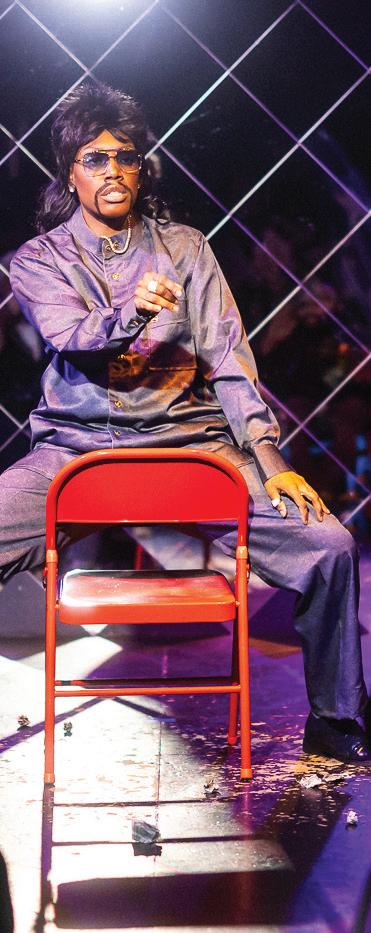

PUBLISHER AMBER NETTLES
CHIEF OF STAFF ELLEN KAULIG
EDITOR IN CHIEF SALEM COLLO-JULIN
ASSISTANT MANAGING EDITOR
SAVANNAH RAY HUGUELEY
PRODUCTION MANAGER KIRK WILLIAMSON
SENIOR GRAPHIC DESIGNER AMBER HUFF
GRAPHIC DESIGNER AND PHOTO RESEARCHER SHIRA FRIEDMAN-PARKS
THEATER AND DANCE EDITOR KERRY REID
MUSIC EDITOR PHILIP MONTORO
CULTURE EDITOR: FILM, MEDIA, FOOD AND DRINK TARYN MCFADDEN
CULTURE EDITOR: ART, ARCHITECTURE, BOOKS KERRY CARDOZA
NEWS EDITOR SHAWN MULCAHY
PROJECTS EDITOR JAMIE LUDWIG
DIGITAL EDITOR TYRA NICOLE TRICHE
SENIOR WRITERS LEOR GALIL, DEANNA ISAACS, BEN JORAVSKY, MIKE SULA FEATURES WRITER KATIE PROUT
SOCIAL JUSTICE REPORTER DEVYN-MARSHALL BROWN (DMB)
STAFF WRITER MICCO CAPORALE
MULTIMEDIA CONTENT PRODUCER SHAWNEE DAY
SOCIAL MEDIA ENGAGEMENT
ASSOCIATE CHARLI RENKEN
VICE PRESIDENT OF OPERATIONS ANN SCHOLHAMER VICE PRESIDENT OF PEOPLE AND CULTURE ALIA GRAHAM
DEVELOPMENT MANAGER JOEY MANDEVILLE
DATA ASSOCIATE TATIANA PEREZ
MARKETING ASSOCIATE MAJA STACHNIK
MARKETING ASSOCIATE MICHAEL THOMPSON
VICE PRESIDENT OF SALES AMY MATHENY
SALES REPRESENTATIVE WILL ROGERS
SALES REPRESENTATIVE KELLY BRAUN
MEDIA SALES ASSOCIATE JILLIAN MUELLER
ADVERTISING
ADS@CHICAGOREADER.COM, 312-392-2970
CREATE A CLASSIFIED AD LISTING AT CLASSIFIEDS.CHICAGOREADER.COM
DISTRIBUTION CONCERNS
DISTRIBUTIONISSUES@CHICAGOREADER.COM
READER INSTITUTE FOR COMMUNITY JOURNALISM, INC.
CHAIRPERSON EILEEN RHODES
TREASURER TIMO MARTINEZ
SECRETARY TORRENCE GARDNER
DIRECTORS MONIQUE BRINKMAN-HILL, JULIETTE BUFORD, DANIEL DEVER, MATT DOUBLEDAY, JAKE MIKVA, ROBERT REITER, MARILYNN RUBIO, CHRISTINA CRAWFORD STEED
READER (ISSN 1096-6919) IS PUBLISHED WEEKLY BY THE READER INSTITUTE FOR COMMUNITY JOURNALISM 2930 S. MICHIGAN, SUITE 102 CHICAGO, IL 60616, 312-3922934, CHICAGOREADER.COM
COPYRIGHT © 2025 CHICAGO READER ALL RIGHTS RESERVED. CHICAGO READER, READER, AND REVERSED R: REGISTERED TRADEMARKS ® TO CONTACT ANY READER EMPLOYEE, EMAIL: (FIRST INITIAL)(LAST NAME) @CHICAGOREADER.COM
Re: ‘Her painting was her life and her life was painting,’ (about artist Gertrude Abercrombie), written by Kerry Cardoza and included in our January 16 issue (volume 54, number 15)
Extraordinary work. One of my favorites: Gertrude Abercrombie with cat and creepy door (featuring red balloon). —@geeezmo, via Threads
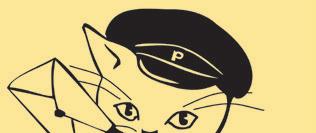


Find us on socials: Facebook and Bluesky: chicagoreader X: Chicago_Reader
Instagram and Threads: chicago_reader
Linkedin: chicago-reader
The Chicago Reader accepts comments and letters to the editor of less than 400 words for publication consideration.
m letters@chicagoreader.com






Palestinian-owned businesses in Chicago keep family traditions alive.
By MALAVIKA RAMAKRISHNAN
Since 1948, when Palestinians were forcibly displaced from their land and homes in an event they commemorate every year as the Nakba, their culture and identity has been under threat. In Chicago, Palestinian-owned businesses have taken on new meaning since Israel’s war on Gaza began in October 2023. They have become platforms of cultural preservation, keeping alive the memory of a Palestine from previous generations.
Bayan Fares is the founder of Badan Collective, a creative design house and educational space that sells and teaches tatreez, or traditional Palestinian embroidery. “Regardless of where anyone is, the Palestinian story is one of redisplacement,” Fares tells the Reader “One of the main purposes of Badan is to be a connection between our generation and the generation that experienced the Nakba. Our parents and grandparents were aiming to survive and rebuild their lives, and now it is time for us to thrive.”
Fares learnt tatreez from her grandmother as a child but reacquainted herself with the method as an adult. “It takes a lot of time to create these items, but they are sustainable. They’re meant to stand the test of time as a piece of identity to be worn with pride, knowing it’s going to last for years,” she says.
Fares conducts tatreez workshops across the country and found that a community of Palestinians like herself are looking to reconnect with their cultural heritage and roots. “Now they can use it [tatreez], especially if they are Palestinian, to innovate and tell their own stories and create works of art. This whole new generation, which was previously disconnected, are now the culture bearers of Palestinian traditions,” Fares says.
Saja Bilasan runs a small business called Falasteen Favorites that sells stickers, tote bags, magnets, and posters on Etsy. Bilasan uses traditional and modern Palestinian mo-

tifs in her artwork to raise awareness for Palestine and its cultural preservation. “I know our people and our culture have been erased through ethnic cleansing. That’s something intertwined with my generation, my parents’ and my grandparents’ generations’ history. I can attest to the fact that, growing up in the United States, we haven’t been able to publicly say, ‘I’m Palestinian,’ and represent our culture until the last year or two. One of the reasons I created my business [in 2023] was because I wanted to be as blunt as possible,” Bilasan says.
As a licensed professional counselor, Bilasan has organized support groups to process the war on Gaza since October 2023. The in-person meetings were local to Chicago and open to Palestinians and others. Bilasan even organized one virtual meeting for anyone in the country to attend. She says her art is meant to start a conversation about what the motifs and symbols mean and how they relate to Palestinian culture. It’s an opportunity to share the history and background of symbols
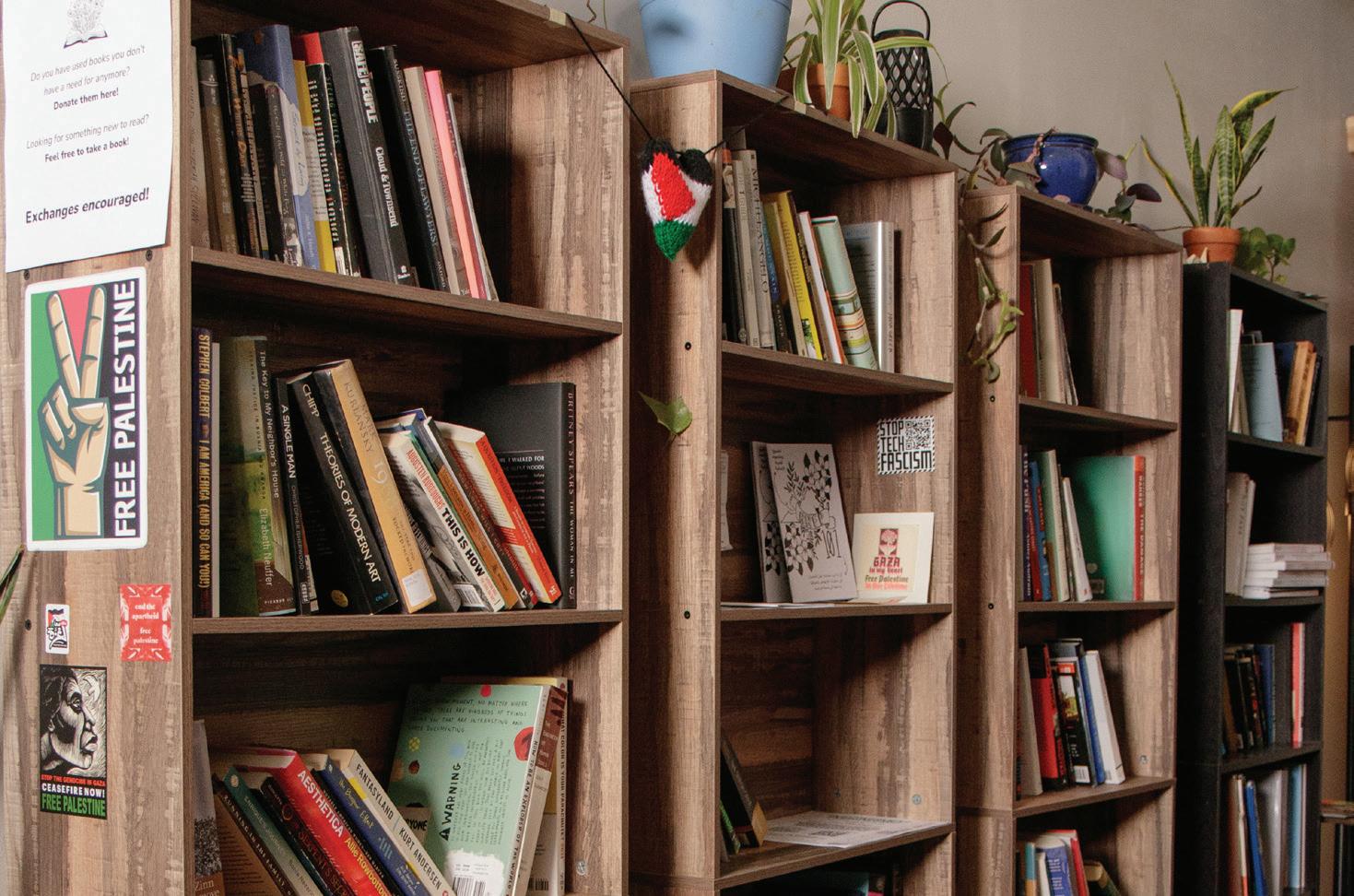



such as the olive tree and watermelon.
“Israel has said, ‘The old will die and the young will forget,’ but my business was created to show the younger generation we’ve not forgotten, but we’re also going to carry on the culture. My generation—we’re the keepers of the culture.”
Bilasan’s friend and fellow entrepreneur Lojayn Ottman specializes in artisan soap with fragrances reminiscent of Palestine. Ottman’s Saboona Soap, founded four years ago, sells eczema-friendly products made of natural ingredients, like goat’s milk and olive oil, which Ottman says were used by her ancestors in Palestine. Her designs can be customized as anime characters, Islamic art, olive branches, or an outline of Palestine.
Saboona Soap’s fragrances are inspired by the plants that grew in her grandmother’s garden before her family was displaced. “When I think about soaps, it’s not just basic elements but what’s special to me. I use guava and pomegranate because they were in the garden. I’m preserving the legacy even though the
house no longer belongs to us,” Ottman says. One of her favorite fragrances, inspired by the smells of Ja a beach, uses sea salt as a base. Ja a was formerly a leisure spot for Palestinians but is now a part of Israel. Ottman says visiting Ja a was a milestone for Palestinian families.
“It’s the place where checkpoints began, and Israel started restricting our travel limit, and Palestinians were no longer allowed to visit the beach. I tell them [customers], ‘Hey, you haven’t smelled Ja a beach in years. Come sample this, and let me know if it smells like you remember.’” Ottman’s liquid soap is connected to her favorite drink in Palestine: mint lemonade. “I thought to myself I would make it into a smell, and it has become my best-selling product.”
Palestinian food, as Bilasan says, has also been stolen and rebranded as Israeli or Mediterranean. Chicago is home to popular Palestinian-owned cafes, Nabala in Uptown and Oud in River North. Both feature products from Palestinian farms and bakeries back home and here in Chicago.
Eyad Zeid opened Nabala Cafe last year to “have a local space for the community,” and it has quickly become a space for meetings and events. Born and raised in Little Palestine in the southwestern suburbs of Chicago, Zeid is a child of refugees and says his childhood and upbringing in the U.S. is a crucial part of how he perceives Palestinian culture. “It’s very much a fusion space o ering a di erent lens to Middle Eastern culture in the Chicago area with the concept of an American coffee shop, and it’s important to know that, as Palestinians, we’ve had to build a culture of our own,” Zeid says.
Oud’s Feras Ghassan jokes that a Palestinian-owned cafe in downtown Chicago is uncommon. Ghassan’s father is from the small Palestinian village of Ein Sinya and moved to Kuwait following Israeli occupation. Ghassan and his family have been in the co ee business for the past 15 years.
Oud’s Middle Eastern–inspired menu incorporates the flavors of Palestine. “Culture is tied to our menu, which has Arabic co ee, cardamom, and different spices. Our signature Oud latte has di erent notes taken from dishes and our mothers’ cooking. A lot of these
experiences were used in the creation of our menu,” Ghassan says. He wants to transport customers to Palestine. “We’ve got pictures on the wall and customers can play the oud here if they want to.” Manakeesh, one of the dishes on Oud’s menu, is a flatbread topped with Palestinian spices like za’atar. Ghassan remembers eating the dish every Sunday for breakfast at his grandfather’s house in Chicago.
Palestinian-owned businesses maintain ties to the homeland by donating money for aid, sourcing ingredients, and working with artists in Palestine. “It just felt a little disingenuous to be a Palestinian business in the diaspora trying to reconnect Palestinians with their culture if we’re not connected to the homeland ourselves. We exist in the diaspora, but not in a vacuum,” says Fares, of Badan Collective. Fares says Badan’s “work has not changed but has deepened in meaning and in impact” since the war on Gaza began.
Falasteen Favorites’s Bilasan puts it another way. “We must carry on what it means to be Palestinian.” v
m letters@chicagoreader.com

Find more one-of-a-kind Chicago food and drink content at chicagoreader.com/food



Pointing out that a restaurant gets you to spend money is rather pointless, isn’t it? Still, few make it as enjoyable and easy as Sushi Plus, a rotary sushi bar that boasts three different locations in Illinois: Chinatown, Northalsted, and Aurora.
Food being served via machine could risk feeling impersonal, but conveyor-belt restaurants are so novel that it’s just fun to have easy access to fresh sushi on rotation right at your table. And if you do happen to order something o the menu, you’ll barely miss the lack of human contact when it’s delivered by a miniature train (on a separate track, don’t worry).
That’s not to say Sushi Plus doesn’t have servers who are attentive and more than willing to answer your questions— it’s merely that the fun, casual space is the main charm.
Tasty fun has rarely been done so well. —ANDREA











































THOMPSON SUSHI PLUS ROTARY SUSHI BAR 2131 S. Archer, 312-929-2446, rotarysushi.com v










































I mostly stick to the Chinatown location; the atmosphere there is a whole vibe, featuring 3D paintings, a claw machine, and a wheel of fortune (with real prizes) on the wall. Just keep track of the spending—color-coded plates of delicious sushi options sliding by on a conveyor belt tend to add up quickly.
Reader Bites celebrates dishes, drinks, and atmospheres from the Chicagoland food scene. Have you had a recent food or drink experience that you can’t stop thinking about? Share it with us at fooddrink@ chicagoreader.com.









generating $874 million for the Illinois Common School Fund.





















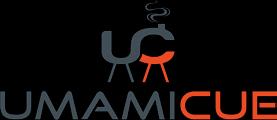










































Fri., Feb. 21 • 5 PM FRANK AND MARY’S TAVERN
2905 N. Elston
$35 Preorder via Tock
State lawmakers and prison workers say the move is necessary to curb overdoses behind bars—despite little evidence it will help.
By DEVYN-MARSHALL BROWN (DMB)
Illinois lawmakers and prison guards are ramping up efforts to ban physical mail into state prisons, blaming syntheticdrug-sprayed paper for a rise in overdoses behind bars. Similar policies are being pushed across the country and have already been approved in at least 15 states, including Pennsylvania, Missouri, and Texas.
Two proposals filed in the Illinois General Assembly as of the February 6 bill-filing deadline would require the Illinois Department of Corrections (IDOC) to ban most physical mail into state prisons. One measure is sponsored by Republican state senator Terri Bryant, a former prison worker who has led the charge for digitized mail in Illinois facilities. The other is backed by Republican state representative David Friess and Minority Leader Tony M. McCombie.
Against this backdrop, WTTW recently reported that IDOC signed a contract in October for phone and video calls and email messaging with prison telecom servicer ICSolutions that could provide digital mail scanning services at no additional cost to IDOC.
The American Federation of State, County, and Municipal Employees (AFSCME) Council 31, which represents IDOC correctional officers, has argued that drugs are entering Illinois prisons through the postal service, harming not only incarcerated people but also the guards who handle their mail.
The union released a report in September that claimed staff needed medical care or hospitalization on multiple occasions because they were exposed to drugs or drug use by incarcerated people, often through the mail, though actual evidence of drug-induced health consequences remains rare. The report argues that insecticides, like wasp and roach spray, and synthetic cannabinoids are sprayed onto paper, cut into smaller squares, and mailed into prisons. The union charges that drugs are acquired predominantly through legal mail that looks like it’s coming from someone’s attorney but isn’t. AFSCME recommends a shift to photocopied mail where possible and wants IDOC to allow prison sta greater latitude to search legal mail.
“We support the Illinois Department of Corrections’s effort to transition to digital mail as a safety measure,” says Anders Lindall, the public a airs director at AFSCME Council 31, in a written statement.
Kevin Blumenberg served 30 years in Illinois prisons, and he says he was shocked by the push to ban physical mail from prisons. Blumenberg thinks legislators and correctional o cers are just trying to create the conditions to further profit from and exploit incarcerated people and says they should instead scrutinize existing security measures.
By the time an incarcerated person receives their mail, it has already been opened and scoured. According to IDOC’s website, individuals in custody cannot receive mail that contains things such as stains or discoloration; crayon, glitter, or other foreign substances; craft materials; stickers or tape; cloth, hair, white-out, cologne, or magnets.
Blumenberg says when he received legal mail, prison guards would bring it to his cell, open it, tilt it upside down, and dump out the contents to search it for contraband. They sometimes even quickly perused correspondence to make sure it was truly legal mail.
Blumenberg has been home for more than five years now and is a lead organizer for Parole Illinois, an organization trying to bring back parole. He says he still has pieces of mail he received from loved ones who are no longer here, and he considers it part of his personal archive.
“If something is getting in, that means that there’s a breach somewhere. That’s what you need to be fixing, not talking about dismantling and destroying the whole system that has a very vital significance . . . for most individuals who will one day return home into society.”
Benjamin Ruddell, director of criminal justice policy at the American Civil Liberties Union (ACLU) of Illinois, says it’s essential to ensure the safety of people who live and work in state prisons, but there is no evidence that mail is the predominant source for contraband entering IDOC facilities.
“It is very clear that contraband is brought
into prisons through other means besides just the mail,” Ruddell says. “The Department of Corrections is not going to be able to e ectively alleviate the real health and safety risks [of drug overdose and exposure] . . . if they’re not also addressing the issue of drugs being brought into facilities by individuals, by sta , visitors, and others. It’s not simply a mail problem.”























A bill filed by state senator Willie Preston seeks to protect the right of incarcerated people to receive physical mail. It requires that prison officials provide an original, physical copy of correspondence and allows for exemptions only in limited circumstances when supported by evidence that shows “the number of mail items containing contraband, test results of mail tested due to suspicion of mail containing drugs, [and] data on where inside a correctional institution or facility contraband has been found.”
Ruddell says other states that switched to digitized mail haven’t seen a decrease in the amount of drugs getting in. Pennsylvania, for example, moved to scan most mail into prisons in 2018. In the years since, overdoses have continued to rise, according to the PatriotNews . The Nation reported in 2021 that the scanned mail provided to incarcerated people often includes unrecognizable pictures and missing pages. One incarcerated person, according to the Nation, told his mother to stop sending heartfelt letters and cards because he couldn’t tell what was sent.
IDOC did not respond to the Reader ’s request for comment by press time. In October, spokesperson Naomi Puzzello told southern Illinois TV station KFVS that the agency is looking into additional options to explore safety and has already shored up mail screening protocols in the meantime. “These e orts are focused on improving safety while ensuring individuals in custody maintain essential


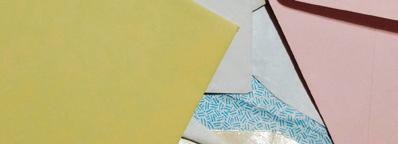




communications and family connections,” Puzzello said.
Blumenberg says that personal touches in letters and cards can’t be replicated by digital copies. “When I was incarcerated in those dark places, sometimes it’s that little, tangible letter that you have that is uniquely written in your loved one’s handwriting that you’re able to see and touch, read it, and [it helps] you push through being in that dark place.”
He says that letters and drawings from loved ones on the outside help incarcerated people stay engaged with their communities and improve their chances of reintegrating into society.
Blumenberg also worries about the security concerns that come with a digital system. Digital mail processes can be subject to censorship, delays, surveillance, and potential data breaches. “Writing a letter to somebody and sharing your thoughts with them is one of the most intimate things you can do with somebody that’s incarcerated,” he says. “You share bits and pieces of yourself with them, and that’s personal. That’s not something that you want to share with everybody else.”
Ruddell plans to fight efforts to digitize mail in Illinois. “Our hope is that they won’t be assigned to committees or won’t get hearings, because these aren’t bills that should be moving forward.” v
m dmbrown@chicagoreader.com
We’ve done this work for over 53 years, and just like you, we can’t imagine a Chicago without the Reader. Right now, we need your financial help more than ever.
In 2024, we published:
46 dance reviews
311 theater reviews
202 film reviews
325 music previews
We can’t do this without you.
We’re not ready to stop this work. Chip in today. Share on social media. Donate now

By YARENI MURILLO
Ipulled out the white sheet of paper wedged into my front door. “Emergency Assistance Center” was written in bold caps, o ering support for those a ected by violence. “Oh,” I thought, “I guess that includes me?”
Last year, on December 2, eight people were shot in Gage Park, just a four-minute drive from my home. Three of those people were killed.
You would think that maybe this would result in more conversations about gun control or city crime rates. No, it’s time to blame the immigrants.
The comments on local news station stories about the incident on TikTok, YouTube, and Facebook are filled with viewers blaming “the Venezuelans.” Apparently, some people think that the crime scene was a house inhabited by recently immigrated Venezuelans. This fact has not been proved at this point, and honestly, I couldn’t care less if it’s true.
Immigrants are not the problem. They almost never are, but they make great scapegoats. Immigrants have had lower incarceration rates than people born in the United States for the past 150 years, according to a 2023 National Bureau of Economic Research study. The study uses data from 1870 to 2020, and it shows that since 1960, immigrants have been 60 percent less likely to be incarcerated.
The number of Latin American immigrants in Illinois in 1990 was 358,619, according to the Migration Policy Institute. According to the Chicago Police Department’s 1990 annual report, in Chicago during the same time the number of violent crimes committed was 82,744, with murders accounting for 851.
By the end of 2022, approximately 1.7 million immigrants, from all parts of the world, lived in the Chicago metropolitan area (according to research by the Vera Institute of Justice). CPD’s 2023 report stated the number of violent crimes to be 26,392, with murders accounting for 711 of those.
Many immigrants from Latin American countries have moved to Chicago since 1990, yet the number of crimes has gone down.
What many fear from this large wave of Venezuelan immigrants is the Tren de Aragua, a transnational gang originating in the country, with some suspected members coming into the U.S.
In September of last year, viral social media
to reporters at Colorado NBC a liate station 9NEWS. “It’s a real issue. It’s being dealt with. It’s isolated.”
NBC News reported last June that U.S. law enforcement and immigration were investigating more than one hundred crimes connected to suspected members of the Tren de Aragua gang in several states. As of September, NBC Chicago confirmed at least two members had been arrested in Cook County for narcotics- and weapons-related charges.
Let’s imagine all one hundred criminal charges were in Chicago, and all the defendants were hypothetically found guilty after a fair trial. More than 30,000 of Chicago’s newest immigrants are Venezuelan. So those one

posts claimed that Venezuelan gang members, including members of the Tren de Aragua, had taken over a Chicago apartment building. This caused an uproar, but authorities said “it was a spread of misinformation” and “exaggerated,” according to NBC Chicago.
Around the same time, a similar situation played out in Aurora, Colorado, based on similar viral memes and videos. “It’s overwhelming our 911 system, or our emergency call center, and so it’s actually hurting our ability to respond to crime. . . . I think we’re in some sort of environment of hysteria right now over this,” Aurora mayor Mike Co man said
of the free.
There will be people who turn to crime in the mix, because humans are human, and all people can do bad things. Despite this, immigrants contribute far more to society than their low crime rates.
In 2022 alone, almost 48 million immigrants among an overall population of roughly 335 million generated around $1.6 trillion in economic activity in the United States. Immigrant households also contributed more than $579 billion in local, state, and federal taxes, according to an American Immigration Council analysis of U.S. Census Bureau data.
Undocumented immigrants’ spending power totaled more than $254 billion in 2022, and undocumented households had a combined income of $330 billion, paying nearly $76 billion in taxes, according to the same study.
If the city wants crime to go down in Chicago, targeting an entire group of people isn’t going to do much.
First off, start by actually solving violent crimes. In 2022, there was no arrest in 63 percent of violent crimes reported to law enforcement in the U.S., according to the Council of State Governments Justice Center. Possible ways to improve this include reducing detective caseloads and quickening the turnaround at state crime labs.
More importantly, prevention is key. This can be done by increasing social and public health services, supporting culturally responsive violence reduction programs and trauma resources, and improving neighborhood infrastructure.
All of these measures can be conducive to preventing crime problems. As for guns, policy can be put into place. Implementing more comprehensive background checks and more attention to gun trafficking can aid in fewer weapons on the street.
hundred people aren’t even a tenth of the population that has immigrated here since 2022. One hundred people aren’t even a tenth of the population that risked their lives—and their families’ lives—because their choices were to wait for death or die trying to live. How can the actions of a few mark the character of thousands?
As I make my way home, I see mothers on the Red Line, carrying their babies, selling chocolates and candies, trying to earn a living. I see young men o ering to clean car windows or help me with my grocery bags. I see people—people trying to live in the land
Around here, there’s a saying when bad things happen to people: “No andaban en cosas buenas,” meaning “They weren’t involved in good things.” It’s a victim-blaming rhetoric, but that doesn’t stop people from saying it, because it makes them feel safe.
Right now, there still isn’t a full story on what happened on December 2, but loss of life is always a tragedy. When tragedies happen, people like to point fingers. Pointing fingers usually doesn’t solve problems, and pointing fingers at a large group of innocents seeking a better life isn’t helping anybody or making the streets safer. v
m letters@chicagoreader.com
Layne Fargo’s latest novel is Wuthering Heights meets the figure skating world.
By EMILY MCCLANATHAN
Wuthering Heights , but about figure skaters. It’s hard to remember the last time a new novel had a premise more tailor-made for me than The Favorites by Chicago author Layne Fargo. And it sure lived up to my hopes; Fargo executes this concept with all the fast-paced turns and heightened drama of a winning ice dance performance.
But you don’t have to be a fan of Emily Brontë or figure skating to appreciate this novel, with its fierce heroine, messy love triangle, high-stakes setting, and page-turning plot. I raised my eyebrow when I saw that the
their tough circumstances. Heath spent his early years in the foster system, and Kat is an orphan living under the guardianship of an abusive elder brother. As Kat teaches Heath to skate on frozen Lake Michigan and they train as ice dancers at a local rink, the two become everything to each other, on and o the ice. “I loved Heath Rocha before I knew what love was,” Kat reflects.
When their talents launch them from obscurity into a prestigious training program in LA, the class di erences at the heart of Wuthering Heights perfectly translate to the glamour and elitism of the figure skating world. Before long, the pressures of their new environment threaten to tear the infatuated young couple apart. “His love for me hadn’t been motivation enough to reach his full potential,” Kat later says of Heath. “His hatred, though? That made him capable of anything.”
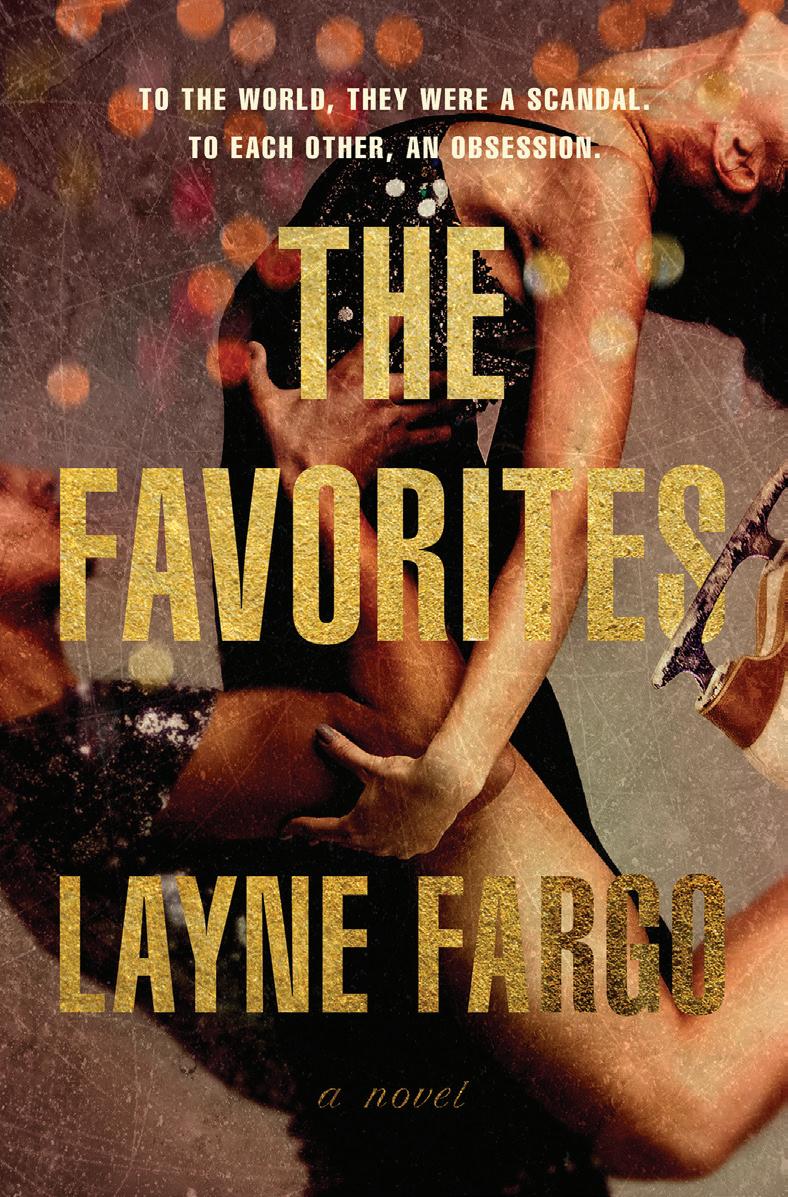
was surprised—ultimately, pleasantly so—by the individual growth of Fargo’s characters and the downright wholesomeness of some moments. But Brontë acolytes can rest assured: there’s enough backstabbing by morally gray characters to convincingly transport this Gothic classic from the gloomy moors of England to the glaring lights of Olympic ice. v
m letters@chicagoreader.com
Kat’s narration alternates with transcripts from a fictional documentary being released
The class differences at the heart of Wuthering Heights perfectly translate to the glamour and elitism of the figure skating world.
publisher bills it as a romance, since Brontë’s original is no sentimental love story but rather a twisted saga of jealousy and revenge. Fargo’s version has all the envy and rage—and yes, some mildly spicy romance—but The Favorites is also a cautionary tale about ambition, with a dash of commentary on celebrity culture.
Much of the prose is first-person narrative by fictional ice dancer Katarina Shaw, a retired Olympian looking back on her on-again, offagain skating partnership and personal relationship with Heath Rocha. The pair grew up together in a fictional Chicago suburb called the Heights, but the North Shore setting belies
ten years after the shocking end of team Shaw and Rocha’s career. With commentary from former training mates, rivals, coaches, judges, and journalists, these interludes provide context about the sport and drop juicy hints about the drama to come.
Fargo’s pacing is relentless; nearly every chapter ends in a cliff-hanger or teaser that makes it hard to put the book down. Although several plot twists feel far-fetched, it’s only fair to allow for some salacious fiction when figure skating is the source of real-life scandals such as those surrounding Tonya Harding and Kamila Valieva.
Given the darkness of Wuthering Heights, I
RThe artist is present Linye Jiang explores the distance between landscape and photographer.
In her solo show “Undisclosed Location” at the Chinese American Museum of Chicago, lens-based local artist Linye Jiang explores the distance between landscape and photographer in a series of quiet and surreal encounters. Historically monumentalized and framed to appear untouched by those who set out to capture it, landscape becomes something entirely different for Jiang: a place for interaction, intimate and fleeting. The exhibition is a breathtaking entrance into the museum’s ongoing Spotlight Series, which celebrates the work of contemporary Chinese American artists and is curated by artist and educator Larry Lee.
Jiang’s photographs use duality to negotiate between tranquil scenery and human presence. The works are pairs of repeated images, with one altered by the presence of the artist. Opening the exhibition, the diptych Butterfly allows its images to be viewed concurrently, directly illustrating the interaction between place and person. Its first photograph lingers on a moment of debris washing ashore on a muddy beach, and its second disrupts the image with Jiang reaching longingly upward over the beach, outstretching a finger toward a single butterfly amid the detritus. In Aquatic Plants, a double-sided work hung on a wire stretching across the gallery, verdant tops of small vegetation emerge from murky water, glittering as they pierce the water’s surface. On the verso, Jiang rests serenely in front of the rippling water, face cupped by an anonymous hand.
Quiet subjects and overlays of the artist create a dreamlike atmosphere, emphasizing the private and ephemeral moments of exchange experienced when fully present in nature. The scenes Jiang chooses to depict are secluded but familiar—a lone island, a rocky mountaintop, birds flying in the distance. Though the locations remain undisclosed, a feeling of recognition arises, situating viewers in the brief, vulnerable moment of exchange. —NATALIE JENKINS “UNDISCLOSED LOCATION” Through 2/23: Wed and Fri 9:30 AM–5 PM, Sat–Sun 10 AM–5 PM. Chinese American Museum of Chicago, 238 W. 23rd, ccamuseum.org/ linye-jiang-undisclosed-location, suggested admission $8 adults, $5 students and seniors, members free
A first-century statue of the Greek goddess has made its way to Wrightwood 659.
It was recently announced that the Halsted A&A Foundation (president and treasurer: Fred Eychaner) had acquired, and subsequently placed on view at Wrightwood 659 (cofounder: Fred Eychaner), an ancient Roman statue depicting the goddess Athena. The Halsted Athena (as the press release heralding her arrival dubs her) is, like many sculptures in circulation from the time, a composite, with head, body, and arms deriving from different sources. Though this is discernible, it does not diminish the authority or beauty of many moments within the work, especially the serpent-bound aegis on her chest. She is installed in the main lobby of Wrightwood 659 in close proximity to several unrelated works, most notably a large hanging fabric piece with horselike forms emerging from its upper reaches. Placed in this manner she looks, for all the world, like an a erthought.
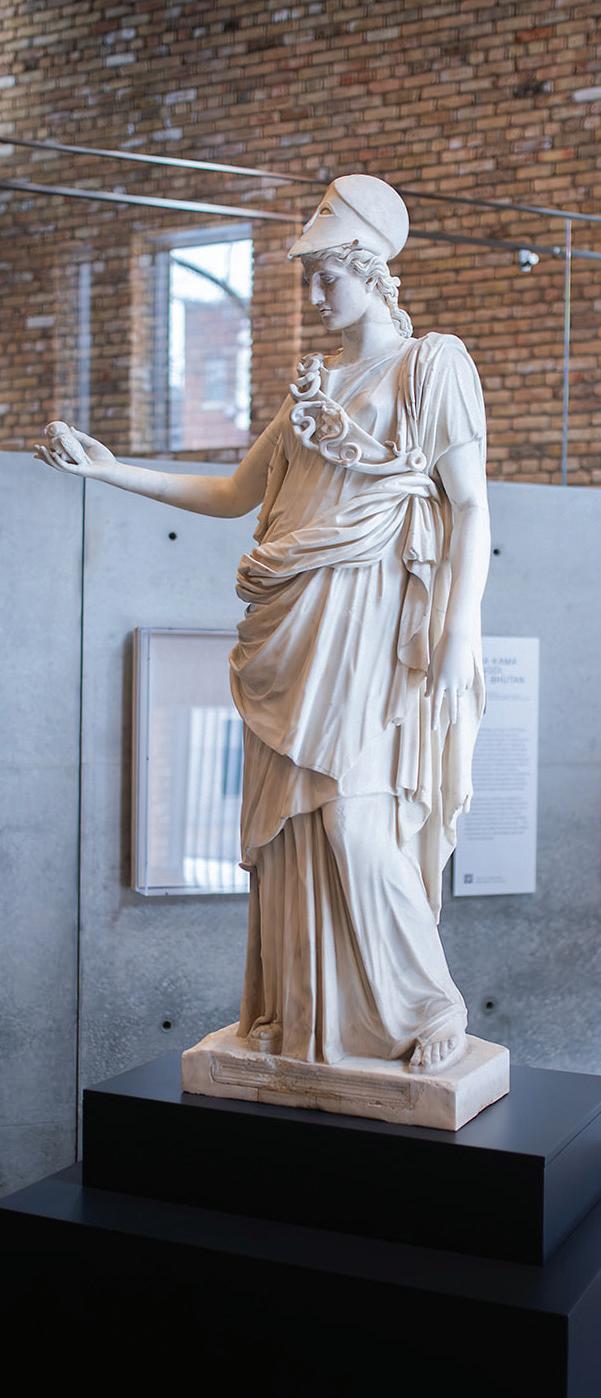
The statue has been promoted as having been “unseen for almost 300 years” which, strictly speaking, is not true. Prior to the acquisition by Halsted A&A, the work belonged for some 260 years in a private collection at an estate in North Yorkshire, England, known as Newby Hall. In addition to having been the set piece for scores of television series and movies, Newby Hall offers public tours, and can be booked for private parties, corporate events, and weddings. One need not look too hard to find photos of revelers dancing just feet from Athena in her old home—a stunning neoclassical niche in the Robert Adam–designed sculpture gallery of the house.
It’s difficult to locate a reason the statue might be better off in its current circumstances than it was for the last several centuries. Nevertheless, if you’re not offended by having to pay the $15 entry fee (I am), go ahead and make an appointment—“Walk-ups are not permitted”—and visit the Halsted Athena. It is, still and all, an antiquity of the early first century CE that has (by whatever means, for whatever reason) made its way to a quiet residential block in Lincoln Park, and that ought to be reason enough to pay her a visit. —BIANCA BOVA Sat 10 AM–5 PM, Wrightwood 659, 659 W. Wrightwood, wrightwood659.org, admission $15 v
Lost my place in the line of love, saw a Queen Bee, Who was quick to give her honey up, To just any tree…, Dropping leaves.
Who to thunk she blow skunk, & kept her lemon sweet, As syrup in promethazine.
So I chased her until we ran out of breathe, Micheal Phelps gold medals & all, But I ain’t do it for the medals, naw.
I wouldn’t lie to you, Rather ride with you. Until the gas tank on E, & four flats on the whip, So let’s tear up the street.
Kick up your feet, Let your toes, taste the wind, against your skin.
While the sun gaze, At its twin.
Let’s dream a dream, That’ll keep us out the seam of things. & forget about time so our patience, Helps us build Kings & Queens. Chuuuch!
By Frsh Waters
Frsh Waters from Chicago’s Westside is a writer, performance artist, & community outreach coordinator for Chicago youth arts non-profit John Walt Foundation and is a Co-Founder of Chicago’s incomparable Pivot Gang. He believes writing is a road map to the world. Frsh is a street food lover & appreciator of art. His mantra is “Change is the crossroads to innovation; either be the change you want to see envisioned on a canvas, or wonder why it doesn’t exist.”
Opening Hours
Wednesday, Friday, Saturday: 11:00 AM–5:00 PM Thursday: 11:00 AM–6:00 PM
More Light! Exhibition Chicago design duo Luftwerk’s immersive interpretation of Aram Saroyan’s poem “lighght” transforms the Poetry Foundation gallery into a dynamic lightbox. Extended through February 15, 2025
Learn more at PoetryFoundation.org



A RAISIN IN THE SUN
Through 3/9: Wed–Fri 7:30 PM, Sat–Sun 2 and 7:30 PM; ASL interpretation Sat 3/1; audio descriptions, open captions, and touch tour Sun 3/2 2 PM (touch tour 12:30 PM); Court Theatre, 5535 S. Ellis, 773-753-4472, courttheatre.org, $58-$100
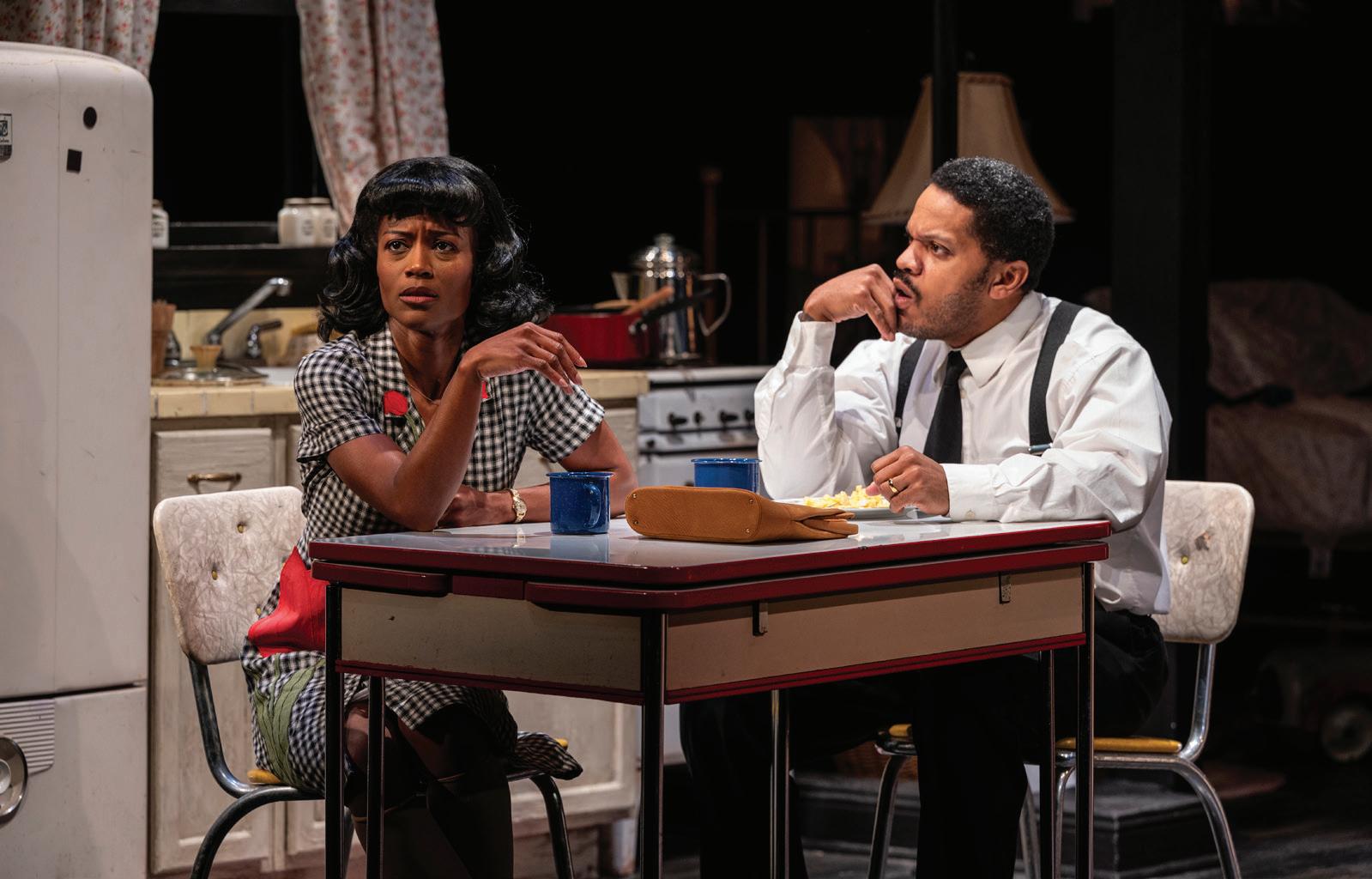
Court’s A Raisin in the Sun is just what we need right now.
By SHERI FLANDERS
Sixty years after her death, Lorraine Hansberry’s masterpiece A Raisin in the Sun, the first play staged by a Black woman on Broadway, arrives onstage at the Court Theatre. Directed by Gabrielle Randle-Bent, this hearty rendition of the story of a Black family in Chicago striving to realize their dreams is more poignant than ever.
Scenic designer Andrew Boyce creates the Younger family home with a scaffolding of bars and lattice that is simultaneously claustrophobic and exposed, evoking the press of inner-city life where nothing is private and personal space is nonexistent—yet the open air above whispers to the possibility of one
day being able to breathe. The play opens patiently, evoking the sense of calm that comes with the early morning hours of the day. Each person emerges from their cocoon of slumber, revealing not just a family, but the legacy of survivors, and the stubborn persistence of a dream that will not be deferred.
Ironically or tragically, $10,000 is still a life-changing amount for many families today, as it was in 1959 when the play originally debuted. Ten thousand dollars is the life insurance payment that mother Lena Younger (played powerfully by a wryly sensitive Shanésia Davis) is to receive for the death of her husband, the family patriarch. With the tragedy of his passing comes new hope to raise the family’s fortunes; to move to a real home; to pay for medical school for the brilliant yet acerbic sister Beneatha (played with delightfully annoying self-righteous aplomb by Martasia Jones); or to jump-start a new business venture for son Walter Lee Younger (a powerfully smoldering performance by an electric Brian Keys).
Walter’s ambition as a Black man in a racist America is the driving catalyst of the tension, playing out the graphic realities of Langston Hughes’s prophetic poem “Harlem” on his family—especially that of his devoted wife Ruth Younger (a stellar, fragile, and vulnerable performance by Kierra Bunch). As Walter struggles with his lack of self-worth, his lack of self-love is reflected onto Ruth with bitter words and scorn for Black women who are

similarly suffering. The devastating beauty of Hansberry’s poetic work is a love letter for women selflessly holding space for the pain of men while subsuming their own pain and attempting to hold onto their own dreams. Ruth, time and time again, pushes her pain to the side in order to serve as the fabric that weaves legacy together.
Contrasting with Walter’s malignant anger and frustration is Beneatha’s friend, Joseph Asagai (a wonderfully magnetic performance by Eliott Johnson), who brings boundless optimism and certainty into the home. As an African man allowed to flourish outside of the racist constraints of America, his freer look on life allows him to see the strength and independence of Black women as a joy instead of an impediment. He gazes on Beneatha and says, “This is what the new world has wrought.” Beneatha’s struggle to choose between Asagai and the more conservative and moneyed George Murchison (played with hilarious aplomb by Charles Andrew Gardner) outlines her challenge to forge her identity as a Black woman within or outside of the constraints of society, but also within marriage.
In a powerhouse ensemble cast, nosy neighbor Mrs. Johnson (a devilishly hilarious J. Nicole Brooks) drops by with some comic relief, juicy gossip, and harsh truths on the real cost of integration. Young Travis (an angelic Jeremias Darville, alternating in the part with Di’Aire Wilson) enjoys a princely naivete as a young Black child unspoiled by reality. Friend
Bobo (a sobering Julian Parker) drops by with bad news, and Karl Lindner (an understated and stoic Vincent Teninty) stops by with a sobering dose of reality, embodied by the phrase, “You can’t force people to just change their hearts.”
Though said in the context of racism, the words resonate with richer meaning for all involved. What does community healing look like? How can we change each other? As Mama Lena frets over her family’s seeming obsession with money, she too tries to nudge their futures to her own desired ends by looking to move to the primarily white (and fictional) neighborhood of Clybourne Park. As Walter tastes the promise of success, we see him begin to grow and change—yet whether that growth will be healthy blooming or malignant hot-air-induced inflation remains to be seen.
The toxic brine of pride, shame, anger, resentment, and bitterness in a man who can’t catch up with his dreams is odious indeed. During one poignant scene where the radio plays the keening strains of Thelonious Monk’s “Round Midnight,” we realize that love and good intentions aren’t always enough to feed the broken soul. Yet Court’s rendition of A Raisin in the Sun proves to us that hope can indeed be more than enough to replenish the heart in the face of seemingly insurmountable odds. And that is exactly what we need in times like this. v
m letters@chicagoreader.com

By CHARLI RENKEN
There are few emotions stronger than love. In fact, I would argue that most emotions stem from a place of love; fear being the anxiety of losing love, anger as the betrayal of love, and as Vision says in the Disney+ and Marvel show WandaVision, “What is grief, if not love persevering?” Love is hard to ignore because, in many ways, it is at the core of the human experience.
This was the theme of Ms. Jeff’s latest In My Feels cabaret night on February 8, part of an ongoing series that focuses on a single emotion in each show. The Newport Theater performance has a little bit of everything: drag, burlesque, live music, poetry, and a whole lot of tears. Each table has a box of tissues on it, encouraging audience members to get emotional.
In true Princess Bride fashion, mawwiage is what kicked off the show. Drag king (and Ms. Je ’s real-life spouse) Bubba Boom sang a tearful rendition of Randy Travis’s “Forever and Ever, Amen” dressed in a rhinestoned tuxedo shirt and jeans. Halfway through, Ms. Je came walking down the aisle in a full wedding


and ask, ‘Why does depression feel this way in my body? What is happening in my mind? What’s happening physically?’”
cash tips, which did not stop flowing for other performers throughout the night.
Headlining the show was Po’Chop (aka Jenn Freeman), legendary drag king and co-owner of House of the Lorde, who performed an equal parts sultry and humorous chair number to “Let’s Straighten It Out” by Latimore. They also transformed later on in the show by slipping into a sleek yet down-to-earth dress for a poetry reading about loving one’s enemies that left me reaching for the tissues.
Another a ecting performance was by Tender Blossom, who appeared onstage tied up by what looked like climbing rope, a paper flower clutched behind their back in bound hands. Birdsong followed by the Postal Service’s “Brand New Colony” played as Blossom struggled to escape their binds. As the words “We’ll cut our bodies free from the tethers of this scene” rang out, Blossom freed themselves and rushed to embrace their real-life partner standing in the aisle, happily presenting their flower, representing queer love escaping heteronormative restrictions for free expression. That was another theme of the night: freedom and resistance from what tries to squash love in all its forms.
dress, a flower crown in their pastel blue and purple hair. When the song ended, the two drag personas were married by stage manager and o ciant Vixen Violencia.
“While Bubba and I are married in real life, we often get asked if Ms. Je and Bubba Boom are married, too, so we decided to make that canon for all of you,” they explained after the number. There wasn’t a dry eye in the house.
After the opener, Ms. Jeff explained their inspiration for the show to get the audience on the same page. At age 18, they were diagnosed with bipolar disorder, a stigmatized and often misunderstood mental health condition. It was a difficult journey but today, they say, they’re in a good place with it.
“People often understand that with bipolar disorder I have intense emotions, but what I don’t think people get is the duration. It just sits with me for a really long time,” Ms. Je , who goes by Je Carrier outside of show business, told me in an interview before the show. “Over the past few years, I found a certain level of peace when I stopped fighting my emotions and just let myself sit with them
That kind of curiosity and emotional immersion is what Carrier hopes audience members will give themselves over to during In My Feels. They do the work to help everyone feel comfortable being vulnerable by walking around the venue and asking people questions about the night’s chosen emotion. “What makes you feel loved? What’s something that makes you swoon? What did someone do recently that moved you?” The audience doesn’t get off with a surface-level answer either; Ms. Je asks them to get specific and curious about their feelings and experiences.
This kind of questioning isn’t just for the theme of the show. Ms. Je has a responsibility to make sure the audience is emotionally open enough to receive the vulnerability performers are giving onstage, too.
Performers ranged in their interpretation of the theme. Obviously, there were several numbers about romantic love—it is Valentine’s Day week after all—but many performances focused on other types of love, like Coco Sho-Nell’s live rendition of Chicago’s “When You’re Good to Mama,” which explored reciprocal, mentoring love. Sho-Nell graced the stage with strong, belting vocals and cheeky references to oral sex, while wearing a black, flowy jumpsuit and a stunning red-and-black rhinestoned wig. And the audience indeed was good to her, showering her with well-deserved
“Love is how we’re going to survive this,” Ms. Je told the audience, firm in their conviction that “We will survive this.” This, of course, being the second Trump administration, which is already taking actions to erase our transgender, immigrant, BIPOC, disabled, and other marginalized communities, members of which made up most of the cast. In My Feels was not just a declaration of love one night at the Newport Theater—it was a promise of love empowering resistance.
The night ended with a story about Carrier and Boom’s courtship: Boom was working nights and sometimes the only moment they had together was over the phone during Boom’s breaks. Carrier would call Boom up and be greeted on the line with a soft “hey.” To bring things full circle, Ms. Je read the lyrics of “Bless the Telephone” by Labi Siffre as spoken word. As Boom’s shoulders shook from sobs, I leaned over and squeezed his shoulder.
The theme of the next In My Feels show in May is Heartbreak, followed by Horny in September. Leave the tissues at home. Ms. Je ’s got ya covered. v
Note: The author of this article takes classes at the Newport and is producing a show there under the drag name Vicious Mockery.
m crenken@chicagoreader.com
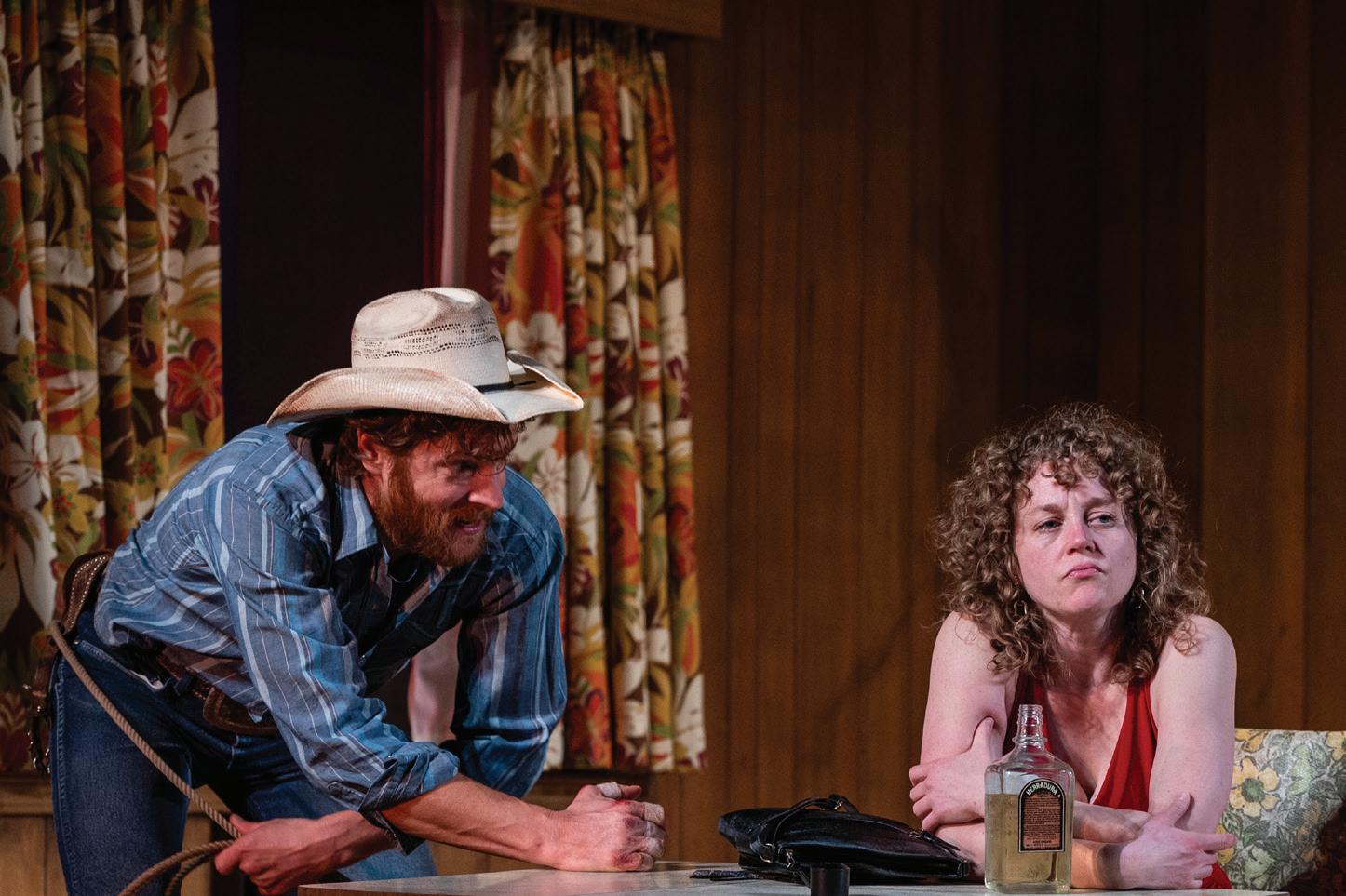








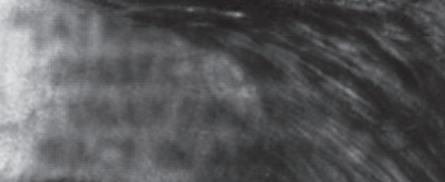










RDon’t worry about a thing
Bob Marley’s Three Little Birds gives kids and adults an oasis of hope.
Feeling glued to the TV and afraid to go outside lately? You’re not alone. Ziggy, the protagonist in Bob Marley’s Three Little Birds, now onstage with Young People’s Theatre of Chicago under the codirection of artistic director Randy White and Tuesdai B. Perry (Perry also choreographs) has a laundry list of fears that keep him inside his Jamaican home: hurricanes, bugs, and the Duppy—a malevolent spirit said to prowl the Caribbean, derived from stories told by the enslaved people brought there. Adapted by Michael J. Bobbitt from a book by Cedella Marley (daughter of Bob and Rita Marley), this sturdy and heartwarming hour-long show serves as an introduction to Marley’s catalog for younger folks and a reminder that “Life is full of danger, but also adventure.” Ziggy (Blake Dupree), urged on by his high-spirited friend Nansi (Brynne London), leaves his house to go to the beach where his mother (Sonia Goldberg) sells jerk chicken from a cart. The Duppy (LaRon Jones at the performance I saw, understudying for Bryan Nicholas Carter) pursues the children, hoping to collect Ziggy’s beautiful hair. But along the way, the avian friends of the title, especially Winter Olamina’s Doctor Bird, provide encouragement. And when things get tense, it’s the perfect time to roll out a Marley classic like the title song, “Is This Love?,” and “Jamming.” (Some additional music and lyrics come courtesy of John L. Cornelius II.) The cast, singing along to prerecorded tracks (Cameron Tragesser is credited as music director) fill the stage and occasionally the aisles with lively embodiments of the characters, and the chemistry between Dupree and London in particular nails the tension between a friend and a possible romantic interest. The kids at the show I attended seemed enchanted by Janelle Smith’s colorful costumes (especially the headdresses for the birds), and the adults were tapping their feet and moving their heads in time to the familiar classic reggae tunes. A fine midwinter escape. —KERRY REID BOB MARLEY’S THREE LITTLE BIRDS Through 3/2: Sat 11 AM and 1 PM, Sun 1 PM; Greenhouse Theater Center, 2257 N. Lincoln, 773-404-7336, yptchi.org, $28.50 ($19.50 under 12), recommended 4+
The Cave marks Sadieh Rifai as a playwright to watch.
Sadieh Rifai’s playwriting debut, The Cave (based in part on her own family’s story), is arguably a little overstuffed at two-and-a-half hours. But this portrait of a Palestinian American family in Ohio at the time of the first Gulf war has so many moments of pure honesty, humor, pain, and revelation that I scarcely minded. It helps that director Alex Mallory’s cast for A Red Orchid Theatre works as a true ensemble, listening and reacting to each other so well that it was easy to believe the family dynamics onstage.
Jamil (H. Adoni Esho) and Bonnie (Red Orchid artistic director Kirsten Fitzgerald) have just moved with their daughters, Dema (Aaliyah Montana) and Noor (Milla Liss), from Las Vegas to Columbus, Ohio, in the wake of a family tragedy. Jamil struggles to earn an income with his never-seen uncles, while Bonnie (who converted to Islam when they married) fends off
the casual racism of nosy neighbor Gail (Ashley Neal), and their daughters try to fit in at a school where their names and Muslim faith mark them as outsiders. When Jamil begins exhibiting signs of mental illness (insisting that he’s being followed into the gated community where they now live, and enforcing a lights-out-at-alltimes policy), it’s hard to know exactly how much of it is attributable to family history, or the trauma of dealing with xenophobia and racism on a daily basis.
Supporting turns from Red Orchid stalwarts Guy Van Swearingen, Natalie West, and John Judd as Bonnie’s family and from Omer Abbas Salem as a creepy and opportunistic fellow member of Jamil’s mosque further underscore Rifai’s de handling of the central question in The Cave: who do you turn to for support when the world seems increasingly terrifying, dangerous, and incomprehensible? Among this cast of heavy hitters, Montana and Liss stand out as two young girls filled with vulnerability, sass, and sorrow. I’m eager to see what Rifai writes next. —KERRY REID THE CAVE Through 3/16: Thu–Fri 7 PM, Sat 3 and 7 PM, Sun 3 PM; A Red Orchid Theatre, 1531 N. Wells, 312-943-8722, aredorchidtheatre.org, $35-$50
windmills of their minds
Lookingglass returns with the rambunctious Circus Quixote.
Adventures await as Lookingglass Theatre reopens its doors on Michigan Avenue a er a dark 18 months with a renovated lobby and the rambunctious premiere of Circus Quixote, based on Miguel de Cervantes’s 1605 novel Don Quixote of La Mancha, written and directed by Kerry and David Catlin, and produced in association with Actors Gymnasium. Beneath the shadow of an edifice of books (scenic design by Courtney O’Neill), Alonso Quijano, soon to be known as the knight Don Quixote (Michel Rodríguez Cintra), devours chivalric romances.
To the consternation of friends and family, he leaves the confines of his chair only to pursue duels against windmills, sheep, and other rural hazards, supported by his infinitely patient squire, Sancho Panza (Eddie Martinez).
The most enchanting moments in this production are the episodes of circus arts, created by Sylvia Hernandez-DiStasi: Quixote’s niece Antonia (Andrea San Miguel) masquerades as a bird looping and swooping in a large net to capture her errant uncle; unearthly Ayana Strutz shapeshi s, contorts, climbs, and tumbles her way through a variety of roles; virtuosic and versatile Laura Murillo Hart sings in the veiled distance as Dulcinea, then metamorphoses into a fabulously unnerving puppet master (with fantastic puppets designed by Grace Needlman) in one of the most compelling scenes of the show.
As for Don Quixote, his visions of valor can seem like the productions of the dried-up brain his companions accuse him of—yet the more bonkers the situations become, the more seductive they get, until we’re all choosing, like Sancho Panza, to believe. —IRENE HSIAO CIRCUS QUIXOTE Through 3/30: Tue–Wed 7 PM, Thu 1:30 and 7 PM, Fri 7 PM, Sat 1:30 and 7 PM, Sun 1:30 PM; Lookingglass Theatre, 163 E. Pearson, 312337-0665, lookingglasstheatre.org, $30-$80
Steppenwolf’s Fool for Love is an exhilarating acting showcase.
Fool for Love isn’t the late Sam Shepard’s best play— despite the high-octane (and o en very funny) stage action and the sorta-revelations about the relationships
embedded in the script, it’s your basic excavation of a romantic folie à deux, with far less to say about the big lies of the American dream than Buried Child or True West. But it is absolute catnip for actors, and Steppenwolf’s current brisk (65 minutes) revival, directed by Jeremy Herrin, demonstrates precisely why that is. If you’ve never seen it, it’s well worth that small investment of time to see this cast in action.
Eddie (Nick Gehlfuss) and May (Caroline Neff ) are longtime on-again, off-again lovers. When Eddie, a stuntman who plays mostly cowboy roles (as opposed to an actual cowboy—crucial distinction!), finds May again, she’s living in a dingy motel somewhere in the southwest (terrific set by Todd Rosenthal), where she fled a er Eddie abandoned her the last time. Eddie’s been in a tumultuous dalliance with a wealthy woman known as “the countess,” who tracks him down and sprays the front of the motel with gunfire, and May has a date with Martin (a scene-stealing Cliff Chamberlain), a nice but painfully dull guy sporting a Flowbee haircut.
Threaded throughout the tense interactions in the motel room (which may or may not remind you of the couple in Tracy Letts’s Bug, but with a decidedly lighter touch) are reminiscences of the Old Man (Tim Hopper, in fine crusty form), who turns out—spoiler alert!—to be the father of both Eddie and May. (A similar revelation is at the heart of Letts’s August: Osage County, which isn’t to say that Letts is derivative—he’s just clearly steeped in the same kind of side-eye relationship with the tropes of American drama and family life that inspired Shepard.) “Neither of them look a bit familiar to me,” the Old Man says, in between making his own self-serving pleas for understanding—he claims that he had the same love for both their mothers, but just split in two.
Neff, long one of my favorites in Chicago theater, brings a beautiful mix of hard and so to May, who is no dummy about how Eddy operates, but who still can’t help getting caught in the emotional lasso he wields. Gehlfuss excels at playing a man who’s made a living playing an archetype, without ever fully understanding or accepting his own heritage and inability to truly put down roots. Their love has made them selfish to each other and the world, just as the Old Man’s passions turned him inward and le him isolated. But watching that passion play out in this production is o en hypnotic, and a reminder of how much Shepard understood the dense and confounding interplay for Americans between individualism and self-destruction. —KERRY
REID FOOL FOR LOVE Through 3/23: Tue–Fri 7:30 PM, Sat 3 and 7:30 PM, Sun 3 PM; also 2 PM Wed 3/5; no show 7 PM Wed 3/5 or Tue 3/11; audio description and touch tour Sun 3/2 (touch tour 1:30 PM), open captions Sat 3/1 3 PM and Thu 3/6, ASL interpretation Fri 3/7; Steppenwolf Theatre, 1650 N. Halsted, 312-335-1650, steppenwolf.org, $20-$138
How to Be Cool calculates the cost of trying to be someone else.
Neil Bhandari’s autobiographical solo show, How to Be Cool, now playing as the prime-time offering with the Neo-Futurists under Anna Gelman’s direction, feels a bit inchoate in the writing, but completely committed in the performance. And even with the digressions that don’t necessarily contribute to the overarching narrative, Bhandari’s show offers a sometimes very poignant look at how the desire to be “cool” can color and distort one’s
life from a young age.
Growing up Indian in suburban Bolingbrook didn’t provide lots of opportunities to become whatever “cool” is, so Bhandari, in order to impress a girl in his school, makes up a story about his family moving out of the city to avoid gang violence. (He even claims that he was stabbed.) Early in the show, Bhandari moves around the periphery of the theater, standing on seats as he hangs up glossy photos of people he deems “cool”—including athletes and actors. He also provides a long, dizzying list of all the things that go into being cool, like “be open to suggestion but not coercion” (which reminded me of Jon Hamm’s “Don Draper’s Guide to Picking Up Women” sketch on SNL —which basically boils down to “be Don Draper”).
In Bhandari’s case, the greatest casualty of his quest for coolness was his marriage, lost in part to the drinking habits he acquired in college. A long path made of empty beer cans provides cogent symbolism of that wrong road. But while Bhandari is a nimble and energetic guide, I felt at times that there was more to the story that wasn’t revealed about the relationships he made (and lost) along the way to figuring out a few things. Perhaps that veiling is itself a form of cool. Nobody wants to give it all away. —KERRY REID HOW TO BE COOL Through 3/1: Thu–Sat 7 PM; ASL interpretation Fri 2/28; Neo-Futurist Theater, 5153 N. Ashland, 773878-4557, neofuturists.org, $20 (pay what you can available all shows)
The Pyg Hypothesis provides a clever gender reversal on Shaw’s Pygmalion.
In a world where men are quickly dismantling the world around us in favor of themselves, it’s hard to imagine a reality in which they’d just shut up and listen. Yet, in Greta Geiser’s The Pyg Hypothesis , making its world premiere at Theatre Above the Law, one man is taught to do just that. A modern adaptation of George Bernard Shaw’s Pygmalion , in which Higgins (Abby Gilster) is a no-holds-barred feminist scholar, is exactly what this moment needs. (For anyone unfamiliar with Shaw’s work, it’s the basis for My Fair Lady .)
If you think the title is a bit on the nose, you’d be right: Higgins’s subject Elijah (Elliot Lockshine) begins the play as a stereotypical bro. He’s piggish in demeanor with disdain for the women of the world. That nature combined with Higgins’s arrogance is only tampered by the delightful calm of Pickering (Sarah Wisterman).
Having studied women and gender studies in grad school, I know all too well the archetypal persona behind Higgins. It’s what the men who don’t want to share fairly like to pretend feminism is. But that overbearing nature captured so expertly by Gilster is quite honestly the best modern interpretation of this character we could have. Geiser’s biting adaptation of Shaw (directed by Liv McDaniel) speaks so eloquently to this moment. You may catch yourself holding back laughter or rolling your eyes with Pickering scene after scene until the final curtain. I was simply left with one thought about Geiser’s work: “By George, I think they’ve got it!” —AMANDA FINN THE PYG HYPOTHESIS Through 3/9: Fri–Sat 7:30 PM, Sun 3 PM; also Mon 2/17 7:30 PM; Jarvis Square Theater, 1439 W. Jarvis, 773-655-7197, theatreatl.org, $15-$25 v
R ROUNDING (2022)
90 min. Fri 2/ 14 –Thu 2/20, Music Box Theatre, 3733 N. Southport, special screening Sat 2/ 15 with postfilm Q&A with director Alex Thompson and actors Namir Smallwood and Bradley Grant Smith, $13 general admission, $10 Music Box members, musicboxtheatre.com/films-and-events/rounding

Local director Alex Thompson’s hospital horror film screens at the Music Box Theatre.
By ZACHARY LEE
There is thrill and terror in the uncanny blurring of what one imagines and what one experiences. A gnawing and restless horror film, Alex Thompson’s Rounding makes one second-guess the shadows that nestle in corners. It focuses on medical resident James (Namir Smallwood), who transfers to a rural hospital after a traumatic incident involving another patient. Under the tutelage of Dr. Emil Harrison (Michael Potts), James tries to start anew and recontextualize his relationship with his vocation, but the arrival of a new patient, Helen (Sidney Flanigan), throws his attempts at rebirth into disarray. Believing that there’s more to her sickness than she’s letting on, he begins to obsess over her well-being, dangerously crossing lines between doctor and stalker as he tries to unravel the mystery. He finds that reality and nightmare begin to blur into each other, haunted by a monstrous, multiheaded creature in the throes of his pursuit.
Thompson spoke to the Reader about bringing his family into the creative process, the newfound relevancy of the film given the focus on health-care injustices, and the role Chicago has played in his artistic life.
This conversation has been edited for length and clarity, and a longer version appears at chicagoreader.com.
Zachary Lee: You’ve shared that Rounding was inspired by B pictures and Poverty Row films. What made you want to set this in the medical world?
Alex Thompson: When I’m circling a project, it’s not only about the story being explored but also about the method of storytelling. My producers, who are good friends, have always encouraged me to make horror films. There’s this sort of assumption that horror sells and you can do it for less. I love food, so I remember thinking that I could do a horror film about a cooking show, but I kept thinking, “Someone else can do this better.” I’m more of a horror tourist in some ways; other people understand and worship the genre and its conventions in a way that I don’t. But the specificity of the medical practice was what caught me. Over the pandemic, there were eight of us in my parents’ house in Kentucky, and three of them were doctors. It was my brother, his friend Justin Gra , and my dad. My brother and Justin were either just finishing medical school or starting their residencies. So there was this feeling of dread amongst everybody, but there was a di erent kind of specificity to it for the doctors. I remember that when my dad would talk about his medical school days, it was very di erent from what my brother experienced. He went to the University of Michigan, which
is a very humanist practice. They teach a new way to think about doctor–patient relationships; the way that doctors have been taught to serve for a long time is very impersonal, and at Michigan, students are taught to internalize that there are people behind these diagnoses. It was compelling to me, the idea that there might be a doctor who, in being very, very good at their job, was also hurting themselves for somebody else.
I’d love to focus on the specificity of the writing and this collaboration with your brother, dad, and Justin. What was the balance of incorporating enough medical jargon to make it authentic but also to make it accessible to the audience?
We worked hard to figure out what Helen’s issues were going to be. Her case was based on a real one that my dad witnessed when he was a young resident. These Munchausen cases are often people who have a relationship with the medical world. Helen’s an outlier in that she’s just a young woman with no discernible connection to the medical world. What was interesting was we got to make James this sort of detective when he’s in the lunchroom. You think of him as this prickly character who’s hard to reach, but when he wants something, he can turn it on. I think of

that scene where he leans into the on-duty nurse and convincingly feigns ignorance when he says, “Hey, I’m new here.” You see a di erent side of him, and I think that ability to chameleon is something that every doctor needs and is authentic to the experience of being in that vocation. It’s a skill set to be able to be a di erent person, to be who a person needs you to be at that moment, and to be something more than exactly who you are at a given time.
Were your family members avid fact-checkers in terms of making sure the medical processes were properly represented onscreen?
Well, occasionally, I’d be like, “How much blood is too much? How much blood could we get away with?” They’d tell me, “Well there wouldn’t be blood in this case, but if he broke through the ribs, then there would be blood.” I wanted the rooms to all feel really alive in the way that real hospital rooms are alive. It’s often very quiet, but stu is always happening with the monitors; people are moving. So my brother and Justin would take all the actors o to a side room when me and my crew were setting up, and they ran improv rehearsals with them. They taught the actors the medical jargon and gave them tasks. That way when we called action, even when the camera was on
continued from p. 15
Sidney in the bed, everybody knew where they were going. They could kind of walk through and they had this well to draw upon. On a rewatch, pay attention to what’s going on in the background.
I like how your filmmaking process is evocative of the sort of humanist-centered approach that Michigan medical students have to take on, in that you can get more done together if you don’t forget to be a person.
There’s a deleted scene where Bradley Grant Smith’s character, Dr. Mac, meets James in the doctor’s lounge; they’re sort of ships passing in the night. Dr. Mac pokes fun at James a bit and says, “You don’t have to walk around a zombie all the time. You can breathe.” You see, in this moment, a sort of humanity between the two doctors. And I think we often forget that there are people on the other side of that N95.
I’d love to hear more about the supernatural elements, particularly the multiheaded wolf that you tease and incorporate in this project.
I think if we hadn’t had financiers who were counting on the creatures, my team and I might have made the crazy choice to not include them. I was listening to a director talk about Solaris [1972], and Steven Soderbergh made an 85-minute cut of the movie just to see if he could. My editor, Mike Smith, and I like to do that, where we might have tried to make a cut of this movie that didn’t have those elements.
Working with Ben Gojer for the creature design, specifically—I picked up Umberto Eco’s The Name of the Rose , and that book places you in the mindset of people really moved by paintings and architecture. For us, for example, if we go to a church or historical site, I don’t think we think, “Whoa, I’d hate to see one of those at night.” But these people did believe in the uncanny, unknowable power of something that was beyond them. I read that book and became interested in how the monks would describe the things they saw and encountered. For example, people who had never seen lions before, when they’d try to draw them, they’d look more like dragons. There’s a creature that repeats in these medieval bestiary books that has seven hooves with the heads of lions. The lions look doglike, though. What I love about the design as they are in the film is that they’re not based on creature de-
signs from A Quiet Place [2018] or something, but they’re based on this ancient understanding of people trying to make sense of the creatures around them. What you see onscreen is sort of six degrees o from real life.
The setting also played a big role in crafting that haunting ambiance. We shot at Dominican University in River Forest for the o ces, hallways, and exteriors of the hospital, and the university as a whole is very cathedral-like.
Your film is coming out at a fascinating and prescient moment when people are thinking about health insurance and the injustices and inequalities of the medical system.
It felt meaningful to me that in the film, James and Dr. Harrison connected, and that Dr. Harrison would take a special interest in James’s mental health. Namir and Michael were filling out intake forms at one point o camera, and I believe Namir wrote that his diagnosis was being Black in America. There’s a real dynamic there that we chose to make subtext. There’s a reckoning taking place, and I think people are realizing that it’s not necessarily that the system is broken but that perhaps the system is working best the more it’s hurting people.
Eagle-eyed viewers will notice settings like Wilmette, Elmhurst, Highland Park, and Downers Grove, just to name a few. Can you speak more about the role Chicago has played in your creative life and process?
I think if you’re a Chicago filmmaker, you’re very independent by necessity. There are not a lot of independent filmmakers who live in Chicago; it’s a small community. I think what the bitter winters, potholes, and horrible traffic don’t show you is that it’s actually like a city of “Yes.” It’s a sandbox for film. I don’t think there are many places where you could say, “I need an abandoned hospital, a university that looks like a monastery . . .” and you can sort of stumble into it and find it. There’s a willingness to figure it out, and that means I’m more excited and comfortable as I work. Rounding could have been a film that took no risks, but because it was made in Chicago, it was able to thrive as what it is. I don’t work exclusively with a Chicago group but people love coming here to work. v





Nothing makes sense anymore, yet still, I do not seek coherence from cinema. There are plenty of excellent films that do make sense, but it’s not the criterion by which I would consider a movie to be good or bad, or worth watching versus not. Something being completely incoherent or nonsensical might compel me to watch it, but never would it turn me away.
My moviegoing this week was laden with such various absurdities, the high point being a Saturday night double feature of RaMell Ross’s Nickel Boys (2024) and Raúl Ruiz’s Love Torn in a Dream (2000) at AMC River East 21 and Doc Films, respectively. (Double the R&R . . . except maybe not rest and relaxation, but restlessness with and reevaluation of dominant narrative forms.) Based on Colson Whitehead’s 2019 novel, Ross’s adaptation is—like his 2018 documentary Hale County This Morning, This Evening —a poetical rendering of its subject matter. Where it may seem “nonsensical” is in its translation of Whitehead’s story, told alternately from both protagonists’ points of view, either assuming their gaze or shot from directly behind their heads. Now, of course, nothing about this is actually nonsensical (except for the structural racism inherent to the film’s story, the real insanity toward which the experimental motifs draw one’s attention). Rather, the film itself is unconventional, but for many the two words are synonymous, believing a traditional narrative structure is the only way real meaning can be conveyed.
In an interview with Vulture, Ross provides a compelling (and rather telling) analogy. “Traditional cinema is the person that’s walking by the homeless person on the street,” he says. “But then being the homeless person on the street and seeing people walk by is a di erent type of filmic experience.” It implies that there is a certain privilege to traditional narratives that are rooted in a safety born of distance, and that to embrace nontraditional modes of

filmmaking might actually be to look more closely at something. There’s understanding to be had in not.
Alternately, Love Torn in a Dream is pure, unadulterated nonsense of the extremely fun variety. Ruiz’s fi lms from the late 90s are considered to be among his most accessible; it’s fi tting, then, that Ruiz followed this more restrained period with an utterly madcap sendup of narrative formulae. He acknowledges this at the film’s beginning, with the producer, Paulo Branco, explaining the nine stories of the film’s labyrinthine plot and their interconnectedness to the film’s cast, who play multiple characters across these threads. Though perhaps slowly, one will eventually “figure out” Nickel Boys , but there’s no such payo to this. There’s also not necessarily a message, nothing to learn, nothing really to gain except for the sheer experience of it. How much in this life is valuable for being worthless?
Unbelievable and nonsensical is the dubbing of Katharine Hepburn as box-office poison following the flop of Howard Hawks’s Bringing Up Baby (1938) upon its initial release, which I saw this weekend as part of the Hawks matinee series at the Music Box Theatre. It’s a wild ride, with Cary Grant as a paleontologist, Hepburn as a zany heiress—and a leopard, the baby of the film’s title. Does it necessarily make sense? No. Is it brilliant in spite of that? Indeed. Not so much the case is Mel Gibson’s Flight Risk (2025), which I randomly saw at an AMC because it’s only an hour-and-a-half long. The plot and runtime had me hoping it’d be a throwaway of the Edgar G. Ulmer variety, but alas, it’s kind of a mess, made worse by the Mark Wahlberg character’s indiscriminate sadism. But that should make the most sense nowadays, right?
Until next time, moviegoers. —KAT SACHS v
The Moviegoer is the diary of a local film bu , collecting the best of what Chicago’s independent and underground film scene has to o er.
Get showtimes and see reviews of everything playing
An animated kids’ version of RoboCop (1987) doesn’t necessarily sound like a great idea. Luckily, Peter Hastings rushes through the high-concept, injured-policeman-has-his-noble-dog’s-head-surgically-attachedto-his-body origin story at lightning speed, and then it’s on to a plethora of other gags. Superintelligent fiendish fish! Sentient monster buildings destroying the city! Midair drone chases! Adorable cat clones! Scribbled kids drawings (which look a good bit like the film’s animation itself) used as heartwarming plot points!
There is a story of sorts scampering around and licking everything amid the chaos. The super-friendly supercop Dog Man is tasked with capturing evil supervillain cat Petey (Pete Davidson), who keeps escaping from the world’s worst-guarded cat jail. (Nepotism is involved.) Then, somewhere along the line, Petey clones Li’l Petey (Lucas Hopkins Calderon). Then he tries to get rid of him. Then Dog Man finds Li’l Petey. Then . . .
But the exact ins and outs of the narrative are significantly less important than the alternation between dumb dog jokes (Dog Man distracted by chasing squirrels, Dog Man licking the chief in the mouth) and frenetic silly surreal nonsense (the town has a mouse and cheese store, and a magic life-restorer factory, AND a volcano?). Hastings is smart enough not to let minor considerations like logic or consistent characterization get in the way of the anarchic Looney Tunes pacing—or in the way of the feel-good ending, for that matter. It’s early in the year, but it’s hard to imagine another 2025 mechanism for delivering giggles to children and adults alike that works half as well as Dog Man —NOAH BERLATSKY PG, 89 min. Wide release in theaters
When you really boil it down, a good action sequence has the same elements as a strong comedic set piece: a clear perspective, a memorable setup with a successful payoff, an element of surprise, and full utility of the talents of the artists involved. A solid punch should knock you out the same way a killer punchline does, so if the cra is there, what’s the worry?
Love Hurts, the latest in the genre, is the worry. Ke Huy Quan leads the film as a star realtor whose crimefilled past is back to haunt him in the form of a parade of hit men, his vengeful mob-boss brother (Daniel Wu), and his would-be valentine, Rose (Ariana DeBose). It’s a fun premise, and Quan—an actor with strong physical comedy instincts—keeps things afloat as much as possible. Under the direction of Jonathan Eusebio (a veteran stunt performer making his directorial debut), the film, running a scant 83 minutes, appears edited within an inch of its life, with scenes slamming into each other with no space and any dead air covered with voiceovers and offscreen dialogue seemingly recorded in postproduction to fill thematic or narrative gaps. The
action scenes—though nimbly performed by a talented team—lack any real visual excitement or creativity, save for an early sequence in which Quan employs a pair of heart-shaped cookie cutters as a ni y weapon.
Perhaps most bizarrely, Quan and DeBose, both uniquely endearing performers, simply have zero romantic chemistry, the movie thrusting them together as a couple more for plot utility than any real cinematic sexual dynamic. These two Academy Award–winning actors deserve to lead films built with care and cra that showcase their exciting talents as physical performers, because when that doesn’t happen, well . . . it hurts.
—BEN KAYE R, 83 min. Wide release in theaters
War thrillers thrive on tension, both kinetic and psychological, but Steve Barnett’s Valiant One delivers only the former. While its premise—a U.S. military helicopter crash-landing in North Korea—introduces a budding narrative with the potential for taut, high-stakes storytelling, the film falters in execution. Valiant One prioritizes surface-level thrills over the deeper existential unease that makes great survivalist cinema such as All Quiet on the Western Front (2022) or The Revenant (2015) so captivating.
The film’s visual language relies heavily on a familiar war-movie aesthetic: handheld cinematography, desaturated color palettes, and tight framing to evoke immediacy. Cinematographer Daniel Stilling (2015’s The Martian) employs shallow focus to isolate characters in moments of crisis, underscoring their vulnerability, but the action sequences, while fluidly choreographed, lack the unpredictability and rawness that might elevate them. Quick-cut editing enhances a sense of disorientation in early moments but later feels like a storytelling crutch, smoothing over sequences that might have benefitted from longer framing with deeper intention.
Chase Stokes plays the hardened military archetype with dutiful discernment, but his performance is driven more by brute physicality than psychology. The boyish charm he’s dazzled Netflix fans with for years in his role as John B in Outer Banks is apparent but familiarly stagnant, incapable of breaking beyond the artistic boundaries of his past work. Lana Condor, in contrast, gives a more matured, textured portrayal through her controlled stillness. It’s a necessary feat to wrestle against the movie’s restless momentum, but it’s still not enough. Perhaps most frustrating is Valiant One’s reluctance to fully engage with its setting; the looming specter of North Korea functions as a backdrop rather than a source of dread, and the film avoids almost any nuanced political or ethical subtext. What remains is a competent and visually engaging action thriller that entertains, sure, but ultimately fails to create an emotional crux audiences will remember. Valiant One, not unlike its protagonist, moves briskly, but in the end, says little. —ANDRÉS BUENAHORA R, 86 min. Wide release in theaters v



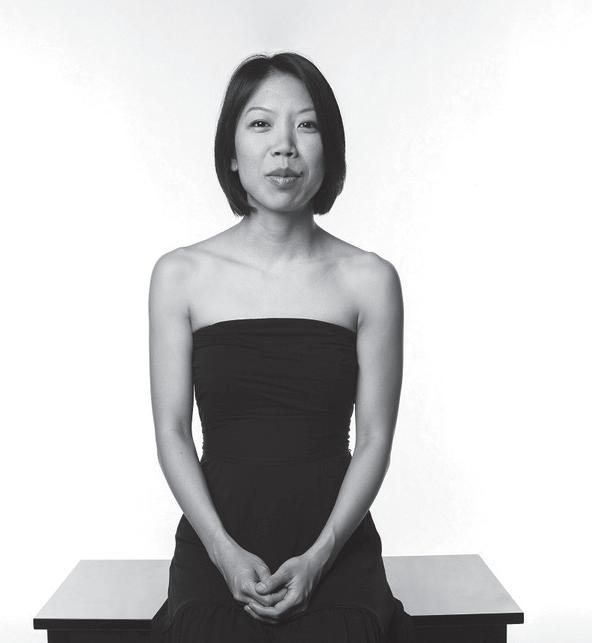


Its seven concerts include the tectonic clarinet drones of John McCowen and Madison Greenstone, a solo program by Chicago pianist Mabel Kwan, and the abstracted Scandinavian folk of Zosha Warpeha.
By BILL MEYER
The Frequency Series draws attention to Chicago’s rich trove of musicians and composers making new concert music and highlights the ways contemporary classical composition overlaps with other forward-thinking genres, including postrock and improvised music. These genres might share the use of minimalist structures, unconventional tunings, chance elements, technologically driven processes, dissonance, or even straight-up noise—and they’re united by a drive to find new forms of musical expression. Former Reader staffer Peter Margasak launched the Frequency Series at Constellation in April 2013, and though he moved to Europe in 2018 (he currently lives in Berlin), he continues to book Frequency concerts today. Margasak also curates the annual Frequency Festival, an outgrowth of the series that’s
now in its ninth iteration. (COVID canceled the 2021 event.) The 2025 festival runs from Tuesday, February 18, till Sunday, February 23, at Constellation and two University of Chicago venues, the Gray Center for Arts and Inquiry and Bond Chapel.
The music presented this year runs the gamut: It includes turntablism, folk-steeped fiddling, jazz-informed trance music, free improvisation, and new classical. Constellation hosts five of the seven concerts. The two U. of C. events, both on Saturday, are the debut U.S. appearances of three musicians from the United Kingdom: violinist Angharad Davies and the duo of keyboardist Pat Thomas and turntablist Mariam Rezaei. Several local artists who’ve performed at previous Frequency Festivals—Ensemble dal Niente, ~Nois, Beyond This Point, and Mabel Kwan—will
present new programs.
Kwan, who plays piano and other keyboards, embodies the cross-genre associations that have informed the Frequency Festival from the beginning. Her increasingly interconnected practice includes performances in classical and improvisatory settings, in established groups as well as ad hoc encounters, and in works of performance art.
Growing up in Austin, Texas, Kwan had fairly typical classical training. She began piano lessons at age eight and developed an aptitude for accompaniment. Her first duo partner was her dad, who liked to sing. She soon graduated to accompanying solo instrumentalists and choirs, and she did a bit of choir singing herself. She developed a love for opera, and in sixth grade she heard a recording of Chopin’s Étude in A-flat Major
(Op. 25, No.1), also called “Aeolian Harp,” and it awakened in her an appreciation of sound in and of itself. While Kwan was studying at Rice University in Houston, she gravitated to contemporary classical music and began to plan her escape from Texas.
“Sometime during my undergrad I decided that I was going to go to Chicago, because somehow, I had an impression that there was a lot of music in Chicago,” she says via Zoom from her home in Logan Square. “There was something else about Chicago that I thought was cool, which was the parks. And it was a bigger city, and it was going to be faster paced than Texas.”
In 2004, Kwan took the leap north and landed in DeKalb, where she attended and taught at Northern Illinois University. In 2006, she finished a master’s in piano performance
at NIU and moved to Evanston, where the following year she became the first regular pianist for Ensemble dal Niente (formed in 2004). She finally settled in the city in 2009 and has stayed ever since.
“When I first moved here, I was just playing contemporary classical music and getting to know folks,” Kwan says. “But I was always interested in improvisation and jazz. I played a little bit in high school, and it was just such a di erent way to play music, that I was always interested in, because I just didn’t know how anyone did it. It was just the most incredible thing to me, because I only read music, but I always went to these shows, when Elastic was in its space above Friendship Restaurant. I would always go check out experimental shows or improvised music.”
Kwan soon crossed the line between being curious about improvising and actually doing it. In 2013 she contributed prepared piano to an album by the 3.5.7 Ensemble, led by bassist Christopher Dammann and saxophonist Nick Anaya, who is also Kwan’s husband. “They were interested in having the kind of piano vocabulary I was playing with in a project, and that’s actually how I started also improvising,” she says. “Up to that point, I had only ever played notated music that was very exacting, like chamber music, where there’s a lot of precision. But with this group, there was something on the page, but I eventually learned that it’s not a perfect guide. That’s really how I got into playing improvised music, and it was just really fun. I also like to do that very exacting work, but I feel like the two work together in some way, and I just really like having both.”
After her session with the 3.5.7 Ensemble, Kwan eased her way into improvised music by playing in Dammann’s group Restroy, where her electric keyboards often held down a core rhythm. Her first totally improvised performance was with tubaist Beth McDonald in 2017, and since then she’s become a frequent presence at Elastic Arts, the Hungry Brain, and Constellation.
More recently, Kwan has appeared on recordings with drummer Tim Daisy, in a quartet with bassist Jason Roebke, and in the ES Trio (with German reeds player Edith Steyer and local percussionist Michael Zerang). On the ES Trio’s The Foreign in Us (released in December 2024 by Relative Pitch), Kwan displays her improvisational versatility: Sometimes she peels off steely fingers-on-strings slides that melt into the other instruments’ sounds, and elsewhere she deploys sparse notes that enclose her comrades’ interactions like the suggestion
of a birdcage.
The music Kwan has chosen for her Frequency Festival set is all composed, however, and it doesn’t make use of extended techniques. “I’m just going to play the keys on this one, but the pieces are very special to me,” she says. “They’re not very experimental. These are just composers that were all kind of in my orbit from the pandemic to now. I feel like the composers all wrote what they wanted to. They each have a very personal voice and language, a thing that they were after, and they went for it and they did it.”
Concerts appear in chronological order. When more than one artist performs, the headliner is listed first.
Varo String Quartet and ~Nois / John McCowen & Madison Greenstone Tuesday 2/18, 8:30 PM, Constellation, 3111 N. Western, $20, 18+
Composer and violinist Noah Jenkins, who earned his PhD in composition and music technology from Northwestern University in 2022, shares an interest in the immersive effects of long tones. Two local ensembles, saxophone quartet ~NOIS and VARO STRING QUARTET, will premiere the Chicago resident’s Poetics of Space Translation Symmetry. The 45-minute piece uses the physical placement of musicians in the room—with strings toward the center and horns at the perimeter—to generate complicated relationships between melody and harmony.
One contrabass clarinet is a nearly bottom-




less resource of rib-rattling sound; put two together, and you can achieve the sonic equivalent of tectonic friction. That’s exactly what JOHN MCCOWEN and MADISON GREENSTONE obtain on McCowen’s recent album Mundanas VII-XI, material from which they’ll perform here. McCowen, a former Illinoisan, currently lives in Iceland, and the undulating, beating drones on Mundanas were shaped by his experience of a barrage of earthquakes that preceded a March 2021 volcanic eruption near his home. Both players use circular breathing to sustain continuous flows of air for upwards of ten minutes whose close proximity in pitch generates combination tones that shimmer like heat lightning.
Beyond This Point / Mabel Kwan Wednesday 2/19, 8:30 PM, Constellation, 3111 N. Western, $20, 18+
BEYOND THIS POINT is a Chicago-based company of percussionists whose repertoire includes multimedia pieces that challenge performance conventions. Their program consists of two duo pieces, Julie Zhu’s Amanuensis (for amplified plywood board, live video, and live
electronics) and David Bird’s Hypochondriac (for live electronics and interactive systems), both of which explore the interactions between computational and biological minds.
MABEL KWAN is a reliable contributor to the Frequency Series, and she seems to be up for any challenge, whether on her own or as a collaborator. In 2019 she performed two pieces by Georg Friedrich Haas that required her to simultaneously play rapid, repeated figures on two pianos tuned a quarter-tone apart, and last month she and two other members of Ensemble dal Niente performed a composition by Jessie Marino for body gestures. She has described her program, which includes solo piano works by Isang Yun, Andile Khumalo, Lei Liang, Tania León, and Sarah Kirkland Snider, as a “meditation on silence, memory, resilience, being.”
Joshua Abrams & the Natural Information Society Community Ensemble / Zosha Warpeha Thursday 2/20, 8:30 PM, Constellation, 3111 N. Western, $20, 18+
JOSHUA ABRAMS is a hypnotic presence in the NATURAL INFORMATION SOCIETY, playing incantatory licks on guembri, a type of Moroccan bass lute. NIS creates long-form pieces that synthesize jazz, minimalism, and the pancultural ethos of Don and Moki Cherry, and when the group performs as the COMMUNITY ENSEMBLE , it expands into a big band with octogenarian tenor saxophonist Ari Brown as the featured soloist. Abrams has composed a new piece for the Frequency Festival that employs no percussion, a rarity for this groove-focused project.
ZOSHA WARPEHA plays a Hardanger d’amore, a recently developed variant of the Hardanger


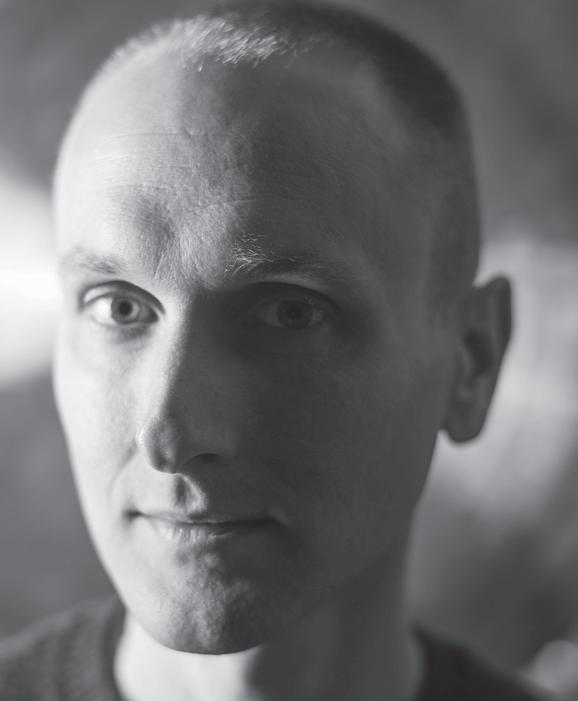


continued from p. 19
fiddle. Deeper in tone than the more famous Norwegian folk instrument, which usually has eight or nine bowed strings, the Hardanger d’amore pairs five bowed strings with five resonating strings, giving it a rich, melancholy sound. Born in Minnesota and based in Brooklyn, Warpeha mostly plays with improvisers such as Carlo Costa and Michael Foster. Her solo music, which sometimes weaves her wordless vocals in among the strings, can be heard on the 2024 release Silver Dawn (Relative Pitch). Though it taps into the spontaneity of improvisation in its use of open forms, it also hews close to the a ective spirit of Scandinavian folk music. This is Warpeha’s Chicago debut.
Mivos Quartet / Ian Antonio plays Jürg Frey
Friday 2/21, 8:30 PM, Constellation, 3111 N. Western, $20, 18+
The MIVOS QUARTET often works with improvisers: The New York–based chamber group has brought its flexibility and precision to collaborations with Ned Rothenberg, Nate Wooley, and Mary Halvorson. Its Frequency Festival program includes two pieces by improvising musicians, trumpeter Ambrose Akinmusire and saxophonist Ingrid Laubrock. For the third, written by Alex Mincek, the quartet will be joined by electric guitarist Nadav Lev. Like Mincek, percussionist IAN ANTONIO is a member of New York–based composing and performing collective Wet Ink. He has also played with Yarn/Wire, Talujon, and Zs, among many other ensembles. After moving to the midwest to teach at the University of Michigan, he undertook an investigation into the austere music of Jürg Frey, a Swiss
composer who’s part of the post–John Cage Wandelweiser Group. Antonio will perform two nuanced, barely-there compositions from Outermost Melodies, his 2024 double-disc set of Frey’s music on Another Timbre.
Angharad Davies
Saturday 2/22, 6 PM, Gray Center for Arts and Inquiry, 929 E. 60th St., free, all ages
ANGHARAD DAVIES is a London-based Welsh violinist who has carried on a dual engagement with free improvisation and composed music since the 1990s, when her brother, harpist Rhodri Davies, recruited her to play in the group Cranc. Like him associated with the New London Silence scene of “lowercase” improvisers, she’s also played with Tony Conrad, whose minimalism is much friendlier to high decibel levels, as well as with contemplative French composer Eliane Radigue. On the 2021 solo album Gwneud a Gwneud Eto / Do and Do Again (All That Dust), she uses insistent bow strokes and a nail file woven through

her violin’s three highest strings to build up a diaphanous cloud of minute sounds. Davies will perform this piece for her Chicago debut.
Pat Thomas & Mariam Rezaei
Saturday 2/22, 8 PM, Bond Chapel, 1025 E. 58th St., free with reservation, all ages
Oxford keyboardist PAT THOMAS covers a lot of ground, but no matter what he does, he works his own angle. He brings a scholar’s understanding of Islamic influences upon jazz to the quartet [Ahmed], applying an uncompromisingly repetitive piano style to the group’s repertoire of material composed by or associated with American bassist and oudist Ahmed Abdul-Malik. He uses electronics in a diversity of settings as well, including freely improvising combos, bands that borrow rhythms from Caribbean music and drum ’n’ bass, and dense solo recordings of carefully abraded abstract sound design. MARIAM REZAEI , a DJ from Newcastle Upon Tyne, uses deft needle techniques on multiple decks to stir broken shards of music lifted from every corner of the record store into a chaotic but flexibly responsive barrage. Thomas and Rezaei have worked together in larger ensembles for several years, but their first performance as a duo was just last month. This concert is not only the duo’s American debut but also the first time either musician has played in the States.
Ensemble dal Niente
Sunday 2/23, 8:30 PM, Constellation, 3111 N. Western, $20, 18+
ENSEMBLE DAL NIENTE was formed more than 20 years ago by Northwestern University graduate students determined to play newly composed music. It has had a relationship with the Frequency Series since the very first concert in the series and has closed nearly every Frequency Festival. This year, its program consists of four pieces (two of which are world premieres) by composers Hilda Paredes, Aida Shirazi, Darlene Castro, and Karola Obermüller. The smallest-scale work is for flute and electronics, while the largest calls for an ensemble comprising a conductor, a vocalist, and 12 instrumentalists. One hour before the concert begins, the musicians and composers will be present to discuss the music that they’ll play. v
m letters@chicagoreader.com


“I love to support others in whatever it is they’re doing. . . . I want to collaborate with people and translate anything that they’re having trouble with.”
As told to JAMIE LUDWIG
Multi-instrumentalist, producer, and mixing engineer Joshua Wells got enmeshed in the Canadian indie scene of the 1990s by drumming in Vancouver-based groups such as Radio Berlin and Jerk With a Bomb. In 2004, he joined his Jerk With a Bomb bandmate Stephen McBean in the psychedelic outfit Black Mountain, who broke out in 2005 with their self-titled debut album. Wells left Black Mountain in 2017, but he’s continued to tour far and wide in other Canadian groups, including Autogramm,
Lightning Dust, and Destroyer. Wells is on the road with Destroyer right now, and they’ll play the Old Town School of Folk Music on March 3.
Along the way, Wells has developed his chops as a recording engineer and producer. In the late 2010s, he traveled to Chicago to record local indie-rock group Spun Out, whose front man, Michael Wells, is his cousin. In 2020, he moved to the city, where he became a full-time drummer with Spun Out and launched his own private studio, the Mango Pit.
My dad was born in the Chicago suburbs. He was a conscientious objector to the Vietnam war. He was drafted in the early 70s, and he fled to Canada and ended up in Toronto, where he met my mom. He’s also a musician, by the way, and so is my mom. So I come from this family of sort of hippie rock musicians.
In 1975, Gerald Ford pardoned the draft dodgers, and my parents decided to make a go of moving here. I was born in a very small
[Illinois] community called Plainfield, in a hippie commune farmhouse. My parents stuck it out for a couple years and realized that America wasn’t for them at the time, so we moved back to Canada. I lived much of my life there, until I moved to Chicago five years ago. My cousin Mike Wells lives here. We got to know each other when I started touring with Black Mountain. By that time, he was becoming a musician himself. Eventually, he was in this band called Ne-Hi, and they began touring around 2018. He asked me to come out here and work on a couple tracks with Ne-Hi, which was really fun.
Right after that, Ne-Hi split up, and he launched into this new project called Spun Out. Before they had even played shows, they were like, “We just want to make this a recording project. Why don’t you come out and produce this record for us?”
So I came out. They’re basically this expanded family collective of musicians. Not everyone played on every song, and there were three main members who were sort of overseeing the project. Because I was there from the beginning, I ended up playing a lot on the record.
Coincidentally, a few years later, I went to Mikey’s wedding, where I met the love of my life, and I decided to move here. I showed up in Chicago in April 2020, which was a pretty interesting time to move. They were like, “You’re in the band now!” So those are the circumstances that led me to Chicago and to basically drop into a very fun and cool and interesting music scene here.
I feel pretty fortunate that I had the kind of upbringing I did, because I didn’t really have anything to rebel against. I was like, “I hate to admit it, but my parents are pretty cool.” As soon as I possibly could, I was playing some kind of an instrument. I settled on the drums when I was nine years old, and as soon as I was good enough, I was playing with my dad and my mom. So I got the opportunity to learn how to play with other musicians and collaborate from a really early age.
“ The way that I learned how to do this stuff is by not having any money. ”
I am, and always have been, a consummate
continued from p. 21
side person. I love to support others in whatever it is they’re doing. That started by being an instrumentalist and feeling out other people’s songs and trying to bring the best I could as a drummer and later as a piano player and guitarist or whatever. At some point, I realized I was approaching it like a producer, and I really felt passionate about it. I want to collaborate with people and translate anything that they’re having trouble with.
I’m not there as a producer to impose any kind of genre or worldview. Certain producers will have their sound that they bring—if you want a hip sound, you hire this person who’s going to bring that. There’s nothing wrong with that. I just like to get into other people’s heads with them and help them translate their ideas in practical ways.
I like to sit down with songwriters or whole bands and listen to their demos or ideas with them, and then sort of go over whether there’s anything that needs to get shuffled around or maybe inflated a little bit. And arrangements—with a lot of the singersongwriter acts I work with, I really enjoy orchestrating their stu , whether it’s drums or some sort of traditional rock instrumentation or getting strings or horns involved. It’s super fun for me, just imagining how to make their music grander and then putting it into e ect.
Spun Out and I share this studio [the Mango Pit]. We rehearse here, but I also do a bunch of recording here, and it’s outfitted in a way that we can do anything, pretty much. But it’s small—it’s one room. It’s modest. If I’m recording someone who doesn’t have very much money, we can do everything here, and if there’s more of a budget, then there are all these amazing, fantastic studios in Chicago. Palisade is one, or Jamdek, or Electrical Audio, obviously.
made sure to suss it out beforehand. It’s fun to do that, because you get to know a new place; you get to know some new people who run a studio. It’s a challenge too, because I’m not really that technical of a person—I’m more of a person who loves ideas. I can plug stu in. I know how to use mikes and compressors, but I’m not focused on that. I’m more like, “Does it sound good? Is it working for the song?” So it can be scary, but it feels great when you manage to pull it o .
The way that I learned how to do this stu is by not having any money. For instance, the first Black Mountain record: Me and the guitarist [Stephen McBean] were trying to make a record. We had been [collaborating] for a long time together in other bands and had been completely unsuccessful. We had zero budget, but we borrowed a tape machine from someone and were like, “Let’s figure out how to work this thing.” We started setting up things and experimenting until we felt we had something.

Last year, I recorded a band called Real Sickies, who are a power-pop band from Edmonton, Alberta. They needed to record in Edmonton. I’d never recorded there, but I just
- FEBRUARY 13,
incorporates this big synthesizer at the forefront and maybe a little bit of fiddly sequenced stu , or something that people could find in bands like the Cars or Gary Numan at that time, or more underground acts like the Screamers from LA. That stu is cool to me because it’s really strange, and it’s on the cusp of two scenes. It was something that happened, but it didn’t happen enough for me, so I needed to start a band that did lots of that.
“Another great thing about Chicago is that there are so many people doing music and art here, and there’s no sense of competition.”
We had zero expectations, because at the time people really didn’t like the music we were making. After we finished that record, Jagjaguwar picked it up, and it sort of blew up in a weird way. We were just shocked. Like, “Shit—I guess we’re going on the road now.” That was some kind of weird universeturning-thingsaround kind of thing. My main interest in electronic music is rooted in Kraftwerk, or basically electronic music of the primordial electronic era—the 70s. I like a lot of the ways in which electronic elements have been incorporated into rock ’n’ roll and pop music. I’m constantly experimenting with that in my arranging. For instance, I’m in a band called Autogramm, which started in Vancouver but is still going even though we’re spread out now. [The band is] really keyed into this weird moment when punk rockers were experimenting with the sounds of Kraftwerk.
So [Autogramm is] like a punk or power-pop band that is really simple and very melodic but
I like all kinds of bands that don’t really fit in a mold. That’s part of my approach to music; I definitely don’t like to do one thing. Autogramm is a great outlet for playing in a punk band that, honestly, not even many punk rockers would accept. Then Spun Out is like a whole other thing. It’s based around a myriad of influences, but a lot of it is just danceable music. And of course Mikey’s voice is a big element to that band. Mikey and I have also been working on another album that’s more of his solo project. It’s just going by the name MV Wells, and it’s sort of an exploration of, like, Burt Bacharach singersongwriter pop with some orchestration.
I’ve also been working with this fantastic Chicago band called Cabeza de Chivo, who are this amazing, super fiery sort of tropical psychedelia cumbia band. It’s been such a treat. I rolled in being like, “What do you guys want to do?” And they’re like, “Oh, we just want to make our first recordings.” “OK, I’m gonna set up the mikes. You guys sound awesome. I don’t really need to do anything here.” Then they were like, “We recorded some basic tracks, but we want to incorporate some dub influences.”
So we took those recordings and we started playing with, like, tape echo e ects and bringing this whole other element on top, which has informed their development in a way. Now they’re incorporating tons of dub stuff live, which is really cool. I worked on their first three singles, which came out [in 2023], and we just finished up an album that’s going to be coming out in the spring.
My friends and particularly my wife know that sometimes my mind just drifts some-
where else. I’ve always had this ability, since I was a child, to completely turn o my senses from whatever’s going on around me and just drift internally and sort of envision things. Sometimes it’s not intentional—it’s a way of dealing with the world around me. But I’ve always been able to tap into something where I can laterally drift and think about what might work here or there. There’s always been that element of coming at something from the side. And of course, there are lots of tools available now that are a lot more accessible than in the 60s and 70s and 80s, and I’m thankful for that, because, you know, I’m not a rich person.
Our studio is really wonderful and also very affordable. We don’t really have any plans to expand [the Mango Pit] into a commercial space. It’s really just Spun Out’s home, and I use it to record other people sometimes. Like I said, there are so many wonderful studios here that I could just drop into, so I don’t need to start a commercial studio where I’m competing with them or anything like that.
Another great thing about Chicago is that there are so many people doing music and art here, and there’s no sense of competition. It’s everyone bringing everything they have to it, and there are these awesome spaces, and everyone works well together. I’m not sure if it’s everyone’s experience, but I even see that there’s lots more cross-pollination between genres here than in other places—like, you’ve got jazzers and indie rockers and people who play cumbia and other amazing Latin styles converging in di erent spots. It could be even more integrated, for sure. But I see lots of cool crossover and potential for more.
[Coming to Chicago] is the best move that I ever made. I would say that solely based upon the fact that I met my wife, and she’s from here, and she’s the best person I’ve ever met. So that was worth it alone. But lucky for me, it’s also just a fantastic place for any kind of artist, musician, or creative person to live. I absolutely love it here. v
m jludwig@chicagoreader.com
Recommended and notable shows with critics’ insights for the week of February 13 b
OF THE WEEK
NEMAHSIS
Fri 2/14, 8 PM, Metro, 3730 N. Clark, $40, $35 in advance. b
I WILL SPEND THE REST of my life sitting with the shock and grief of witnessing the Israeli military’s genocidal assault on Gaza. Add to this the separate horrors of watching Western countries crack down on protests advocating for justice on behalf of Palestinians and enduring the lies of powerful ideologues hostile to the Jewish values I hold dear (first among them Elon Musk) who use my religion as a weapon against anyone who dares criticize the Israeli government. Among those who’ve materially suffered since October 7, 2023, is Palestinian Canadian singer- songwriter Nemah Hasan, who makes arresting pop music under the name Nemahsis. She signed to a Los Angeles label less than a week before October 7; on October 12, she posted that the label, whose identity she hasn’t disclosed, had dropped her with no explanation. Considering that Hasan had been advocating for Palestinians on social media, the label’s silence was answer enough.
Hasan eventually self-released her debut full-length, September’s Verbathim , and every label who took a pass missed out on a knockout pop album. Coproduced by Noah “40” Shebib (best known for his work with Drake), Verbathim supersizes its glistening arrangements by adding sparse, declarative percussion that emphasizes the dramatic stakes in Hasan’s clean, swooning vocals. Her single “Stick of Gum” builds atop what sounds like a tightly wound oud loop as it sweeps skyward to pop ecstasy. Hasan filmed its video on a trip to the West Bank to visit family, assembling an unplanned production on virtually no notice. She wanted to spotlight Palestinians experiencing joy in the face

of their dehumanization on a global scale, and the video shares tender, everyday activities—cooking a meal, enjoying a bike ride—with a world that too rarely sees Palestinians as they see themselves. It’s a prime example of music’s ability to build the empathy and cross-cultural solidarity that can help us survive the worst of times. —LEOR GALIL
Nemahsis See Pick of the Week at le . 8 PM, Metro, 3730 N. Clark, $40, $35 in advance. b
Dua Saleh Shawnee Dez opens. 9 PM, Lincoln Hall, 2424 N. Lincoln, $25, $23 in advance, $73 VIP. 18+
Los Angeles–based singer-songwriter and actor Dua Saleh was born in Sudan, but in the 1990s, when they were five years old, their family fled the country to escape the Second Sudanese Civil War. Eventually, they landed in Saint Paul, Minnesota, but those formative experiences continue to inform their lifelong passion for community organizing as well as their musical artistry. Saleh turned to poetry as an outlet as a child and began performing on the Minneapolis–Saint Paul open-mike circuit during high school. They began to combine their poetry with music, experimenting with studio technology and genre, developing a sound that combines rock, R&B, gospel, and more. The songs on their 2019 debut EP, Nūr , are sparse and airy; on “Albany,” Saleh’s wordless vocals lilt like feathers in a breeze, mingling with the chirps of birds, and on “Warm Pants,” their intimate confessions float to earth amid a sultry groove. They’ve honed their experimental side on two more EPs and their 2024 full-length debut, I Should Call Them (Ghostly International), which explores gender, queer identity, and the joys and pitfalls of love within a loose dystopian narrative. The album will have you wondering what twists and turns lie ahead, and Saleh’s evocative, shape-shifting vocals are delightfully likely to keep you guessing. On the pop-R&B opener, “Chi Girl,” they get breathy and girlish, while on the slow-burning “Pussy Suicide” they use multiple vocal tracks to slide from sweet and clean to husky and distorted. —JAMIE LUDWIG
Emily Jane powers Humdrum and Wolfman open. 7 PM, Schubas, 3159 N. Southport, $15. 18+
Chicago indie artist Emily Jane Powers makes music that foregrounds her expressive guitar. She can thrash with metal aggression or weave gossamer webs out of layers of delicate arpeggios. Up until 2022’s Always, Powers recorded every one of the parts on her albums, not just the guitars, but her new one, Earnest Jamming Partners , features the group she’s enlisted for live shows. Its tunes and arrangements build on the interplay she’s developed with guitarist Ryan Hurnevich, bassist Alec Harryhausen (who also plays in indie-pop group Dream Version), and drummer Dave Piscotti (also of Fauvely), who approach Powers’s material with a light touch that disguises their tough edge. “Form of Being” opens with dueling rhythms on toothy guitars, and when the band open it up for solos toward the end, their punches really wallop.
—LEOR GALIL

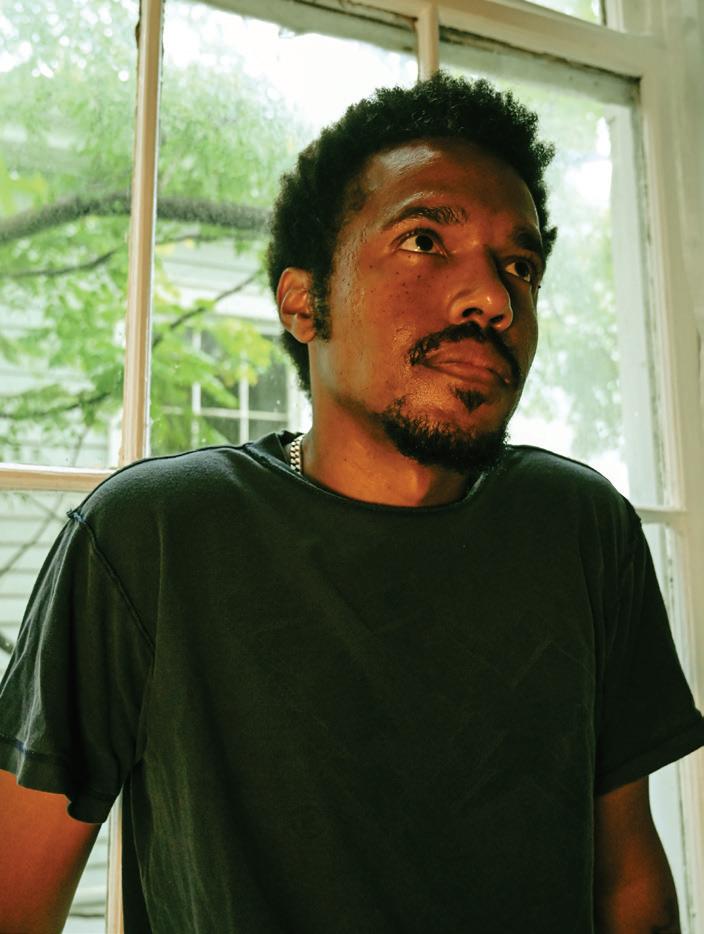

Thotcrime Anita Velveeta, OMG_Aeri, and the World in Broken Glass open. 8 PM, Beat Kitchen, 2100 W. Belmont, $13. 17+
The cybergrind scene spans the world, despite its small size, and Urbana four-piece Thotcrime are one of its foundational pillars—they contribute to a strong Illinois showing alongside Chicago trio Blind Equation. That band renders the portmanteau in cybergrind’s name legible, combining grindcore’s speed-freak attack with chirpy video-game synths, but that’s just one interpretation of the sound—the scene thrives on wild creative leaps. “There aren’t any rules you have to follow,” Thotcrime drummer Dot Homler told Bandcamp in 2021. “It’s okay to just have fun.” Thotcrime dedicated their riotous third album, August’s Connection Anxiety (Aesthetic), partly to Homler, who died in December 2023. The album posits Thotcrime as a band in constant reinvention: They blend their metalcore attack with proggy video-game breakdowns, frothy dance-pop melodies, and sugary singing befitting 2000s emo bands known for their asymmetrical hairstyles. On the back half of Connection Anxiety , Thotcrime apply metalcore’s intensity in quick bursts—a brief blastbeat tantrum, a whiplash-inducing guitar riff— that accent clean, radio-friendly moments. The nakedly accessible “The Wrong Way” rides a fouron-the-floor synth-pop pulse, and because it follows a few broodingly heavy tracks, its chirpy, ecstatic climaxes feel that much more potent. —LEOR GALIL
Benjamin Booker Kenny Segal opens. 8 PM, Subterranean, 2011 W. North, $23. 21+
New Orleans–based singer-songwriter Benjamin Booker broke out in 2014 with a self-titled album of classic blues and rock. He played shaggy guitar riffs with a perfectionist’s focus, and his rough-and-
tumble songs had the grit and power to win over the kind of conservative rock fans who claim “real” music died generations ago. He hasn’t restricted himself to that turf, though: On “Right on You,” which opens his 2017 follow-up, Witness, he pushes his smoky voice into a sandpapered howl so reminiscent of Kurt Cobain that I’ve repeatedly checked to make sure the track isn’t a long-lost Nirvana song. But Booker’s flexibility within the blues-rock idiom didn’t prepare listeners for the shi he made with his new third album, Lower (Fire Next Time), recorded with underground hip-hop producer Kenny Segal.
Segal has won acclaim for his work with Billy Woods, and I’m particularly fond of his collaborations with Chicago rapper Serengeti. On Lower , Segal’s crunchy percussion and resplendent keys bring a new dimension to Booker’s husky voice and frayed guitars. When Booker sings quietly, the thrum he’s cooked up with Segal makes Lower sound like a trip-hop album good enough to inspire a new generation to explore that slow, simmering genre. That’s not to say Booker has suddenly decided to stick to a straightforward style. On his December single “Same Kind of Lonely,” he upends a dreamy melody with a sample of gunfire and screaming taken from a video of a school shooting, which curdles the song’s otherwise hopeful tone. Still, Booker carries on with his song, persevering in the face of unprovoked violence—as I suppose we all must at this moment, when an unelected billionaire is trampling the law to dismantle crucial democratic institutions.
—LEOR GALIL
Cymande Bathe open. 7:30 PM, Metro, 3730 N. Clark, $35, $30 in advance, $130 VIP with meet and greet. 18+
Lots of innovative bands are before their time, but few go on to shape popular music long a er they break up. In the early 1970s, musicians from London’s Afro-Caribbean diaspora formed the group Cymande, whose heavy psychedelic funk shared
messages of hope and peace while blending in elements of jazz, soul, calypso, reggae, and more. On their first single, 1972’s “The Message,” they came on nine members strong, with three horn players and as many as five percussionists, depending on who was doing what at any given moment. Despite their originality and talent, Cymande made little headway in the UK, but they got a warmer welcome in the States. “The Message” reached the top half of the Billboard Hot 100, and in 1973, a er a series of tours opening for superstars such as Al Green and Ramsey Lewis, Cymande became the first British band to play the Apollo Theater in Harlem. They recorded what would become their fourth studio album, Arrival, the following year, but broke up before it came out, worn down by the road and discouraged by their lack of traction at home. (Arrival was posthumously released in 1981.) Guitarist Pat-
rick Patterson and bassist Steve Scipio, the group’s principal songwriters, returned to the Caribbean and became lawyers, and Scipio would later serve for seven years as attorney general of Anguilla. In the early 1980s, though, the music world began to catch up with Cymande, in large part due to the popularity of new sampling technology. Their songs have been sampled so frequently that anyone who’s listened widely to mainstream hip-hop or electronic music has heard Cymande whether they know it or not. (The vast list of artists who’ve sampled the band’s recordings includes Grandmaster Flash, Wu-Tang Clan, Luke Vibert, the KLF, EPMD, the Fugees, De La Soul, and MF Doom.) New generations of fans learned about Cymande, and to respond to this wave of interest, they re-formed for a one-off show in 2006. In 2012 they officially got back together and began to work on new material.
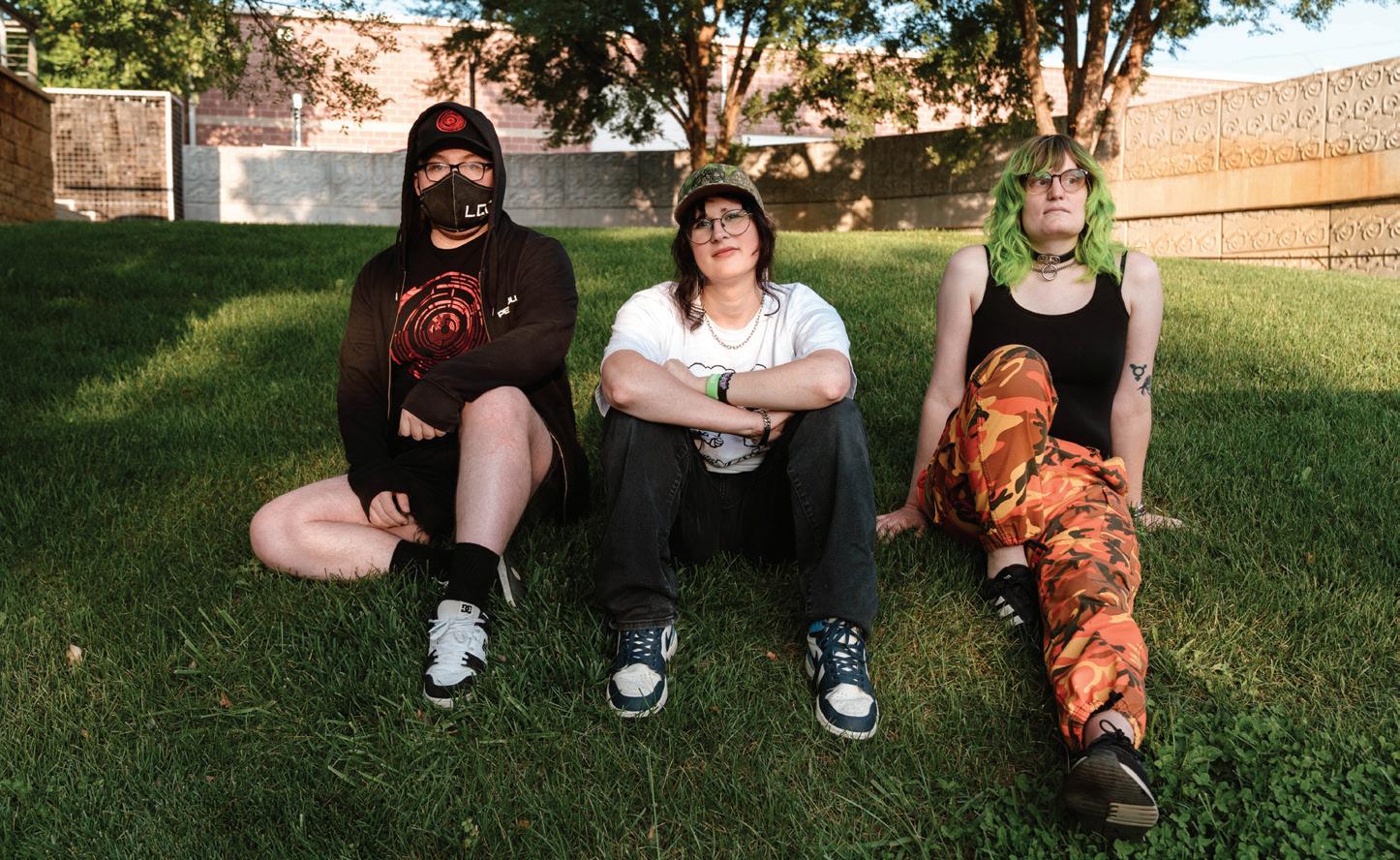
All nine original members have contributed at various times (though percussionist Pablo Gonsales has since passed away), and several new musicians have gotten involved too. Last month Cymande released the second studio album of their reunion
era and sixth overall, Renascence, which harks back to their early sound. This concert is a rare chance to see these funk masters in action—and because Scipio and Patterson are both 75 years old, it’s not to be missed lightly. —JAMIE LUDWIG v
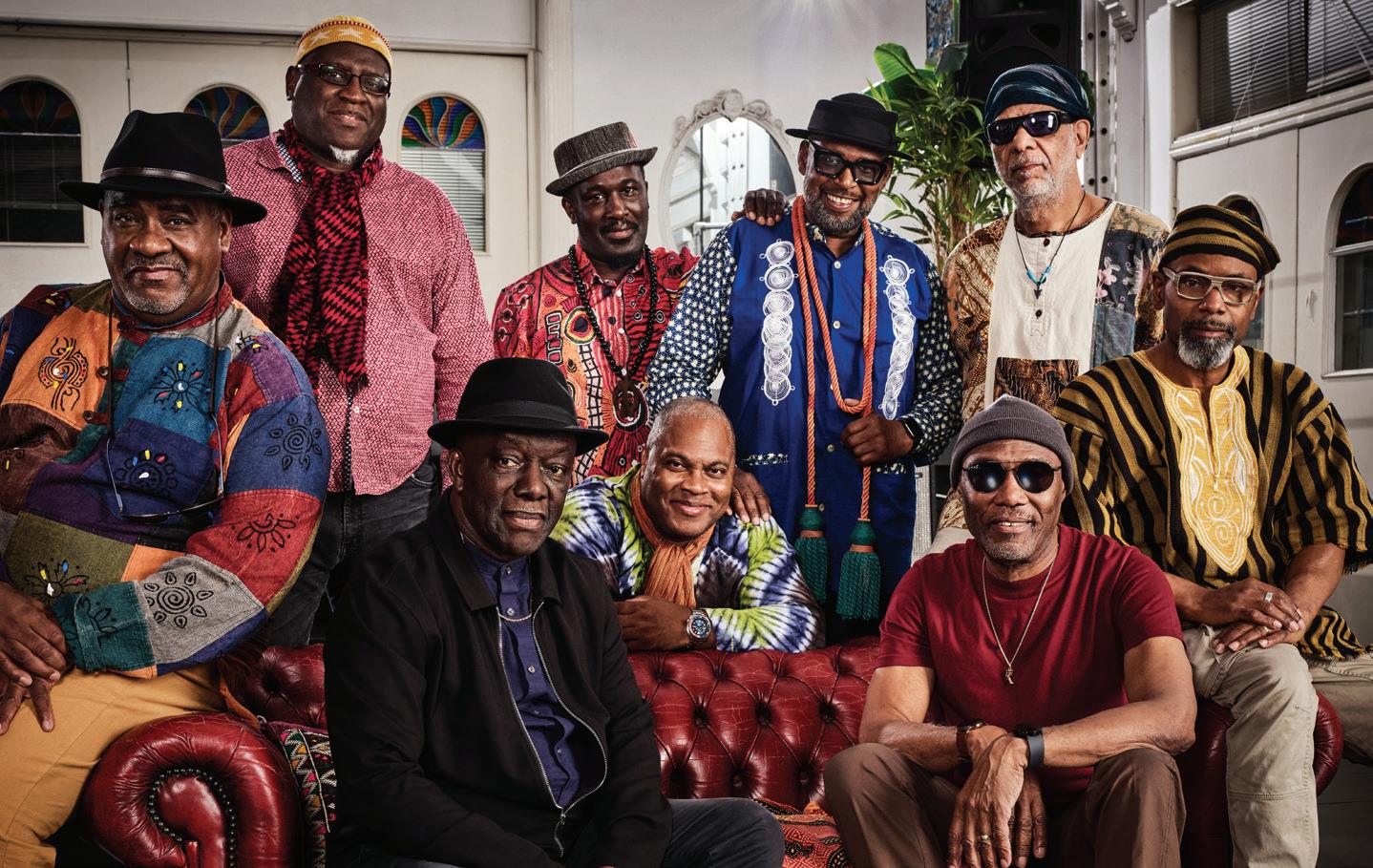


THE SALT SHED THE SALT SHED THE SALT SHED THE SALT SHED THE SALT SHED THE SALT SHED THE SALT SHED THE SALT SHED THE SALT SHED THE SALT SHED THE SALT SHED THE SALT SHED THE SALT SHED THE SALT SHED THE SALT SHED THE SALT SHED THE SALT SHED THE SALT SHED THE SALT SHED THE SALT SHED THE SALT SHED THE SALT SHED THE SALT SHED THE SALT SHED THE SALT SHED THE SALT SHED THE SALT SHED THE SALT SHED THE SALT SHED THE SALT SHED THE SALT SHED THE SALT SHED THE SALT SHED THE SALT SHED THE SALT SHED THE SALT SHED THE SALT SHED THE SALT SHED THE SALT SHED THE SALT SHED THE SALT SHED THE SALT SHED THE SALT SHED THE SALT SHED THE SALT SHED THE SALT SHED THE SALT SHED THE SALT SHED THE SALT SHED THE SALT SHED THE SALT SHED THE SALT SHED THE SALT SHED THE SALT SHED THE SALT SHED THE SALT SHED THE SALT SHED THE SALT SHED THE SALT SHED THE SALT SHED THE SALT SHED THE SALT SHED THE SALT SHED THE SALT SHED THE SALT SHED THE SALT SHED THE SALT SHED THE SALT SHED THE SALT SHED THE SALT SHED THE SALT SHED THE SALT SHED THE SALT SHED THE SALT SHED THE SALT SHED THE SALT SHED THE SALT SHED THE SALT SHED THE SALT SHED THE SALT SHED THE SALT SHED THE SALT SHED THE SALT SHED THE SALT SHED THE SALT SHED THE SALT SHED THE SALT SHED THE SALT SHED THE SALT SHED THE SALT SHED THE SALT SHED THE SALT SHED THE SALT SHED THE SALT SHED THE SALT SHED THE SALT SHED THE SALT SHED THE SALT SHED THE SALT SHED THE SALT SHED THE SALT SHED THE SALT SHED THE SALT SHED THE SALT SHED THE SALT SHED THE SALT SHED THE SALT SHED THE SALT SHED THE SALT SHED THE SALT SHED THE SALT SHED THE SALT SHED THE SALT SHED THE THE SALT SHED THE SALT SHED THE SALT SHED THE SALT SHED THE SALT
WITH SEXTILE FEB 15 FOSTER THE PEOPLE . . . . . . THE SHED WITH GOOD NEIGHBOURS
FEB 22 HOUNDMOUTH .
THE SHED WITH SUSTO
FEB 26 FINNEAS .
THE SHED WITH BAD SUNS
MAR 7 & 8
GREENSKY BLUEGRASS . . . THE SHED WITH KITCHEN DWELLERS
MAR 9 MORGAN WADE . . . . . . . . . THE SHED WITH THE LONE BELLOW
MAR 11 & 12 FAYE WEBSTER . . . . . . . . . THE SHED WITH MEI EHARA ON SALE NOW

FRIDAY, FEBRUARY 14 8PM Mariachi Herencia de México In Maurer Hall
SATURDAY, FEBRUARY 15 8PM BeauSoleil avec Michael Doucet In Maurer Hall
SUNDAY, FEBRUARY 16 7PM Mustafa In Maurer Hall
THURSDAY, FEBRUARY 20 7:30PM Cerqua Rivera Dance Theatre In Szold Hall
FRIDAY, FEBRUARY 21 8PM Solas
30th Anniversary Tour In Maurer Hall
SATURDAY, FEBRUARY 22 12PM Black History Future Folk Symposium
Global Carnival Redux In Maurer Hall
SUNDAY, FEBRUARY 23 3PM & 6PM Ladysmith Black Mambazo In Maurer Hall
WEDNESDAY, FEBRUARY 26 7:30PM JigJam In Maurer Hall
FRIDAY FEB 28 & SATURDAY MAR 1 8PM Hamilton Leithauser
This Side of the Island Tour In Maurer Hall
MONDAY, MARCH 3 8PM Destroyer In Maurer Hall
IN THE DAYS AFTER Donald Trump was declared the winner of the 2024 election, Chicago freelance journalist and multiinstrumentalist Maureen Dunne wanted to do something to push back against the incoming administration’s authoritarian right-wing agenda. She started planning a benefit concert for the Palestine Children’s Relief Fund . That fundraiser, Fields of Palestine , showcases Arab, Pakistani, and Irish musicians on Saturday, February 15, at the Irish American Heritage Center (4626 N. Knox).
Dunne has played cello for 15 years in the Academy of Irish Music , a community folk ensemble based at the IAHC. She helped organize Fields of Palestine as a member of a grassroots activist group called Chicago Irish for Palestine , which formed this past August in the lead-up to the Democratic National Convention. Dunne says CIP wanted to respond to Biden invoking his Irish heritage as his administration propped up Israel’s military assault on Gaza—in part to honor the long history of Irish people resisting colonialism.
“During the DNC, we had a couple teach-ins at various spots around the city,” Dunne says. “We led a contingent of the big march on the DNC.” Since its founding, CIP has hosted cultural programming at Nabala Cafe, a Palestinian coffee shop in Uptown. In October, after Nabala Cafe’s windows were smashed for a second time, CIP organized a GoFundMe to replace the glass, and Dunne says members also helped board up the windows in the meantime.
Ohta Jr. & Sonny Lim In Maurer Hall
A furry ear to the ground of the local music scene
Mikhaiel says Salon Kawakib has had trouble booking spaces larger than the intimate storefront at Eli Tea Bar. The IAHC’s Mayfair Theatre, which hosts Fields of Palestine’s mainstage performances, can fit more than 600 people. The IAHC’s pub, called Fifth Province, hosts music before and a er those sets, beginning with Irish group the Chancers and ending with a jam session.
“Folks who are not affiliated with us can literally roll up with an instrument and join and

admission is $40 ($20 for students), and frontrow VIP tickets cost $75.
CHICAGO’S YOUNG INDIE-ROCK scene is having a busy month, and not just because Horsegirl are dropping their second album, Phonetics On and On , on Matador this Friday, February 14. That night, Fallen Log hosts a Valentine’s Day installment of the Hallogallo Raveup, an all-ages modculture dance party featuring ad hoc groups of musicians from the scene. On Monday, February 17, TV Buddha headline a free show at the Empty Bottle; Friko front man Niko Kapetan opens with a solo set, followed by punk band Bungee Jumpers , which includes members of Answering Machines and P. Noid


Dunne knew she wanted the PCRF benefit to showcase musicians from Southwest Asia and North Africa (SWANA). She plays cello in the University of Chicago’s Middle East Music Ensemble , where her bandmates include cellist Yasmin Zacaria Mikhaiel, who’s also a dramaturg, journalist, and Reader contributor. Mikhaiel is part of Salon Kawakib, a SWANA cultural collective that’s held monthly events at Andersonville’s Eli Tea Bar for a couple years, and they got Salon Kawakib involved in producing Fields of Palestine.
“Maureen is really the one who had so much of the curation of our friends and community,” Mikhaiel says, “and really trying to uplift artists that haven’t headlined or had really long performance times to themselves. As a producer, I had eyes on similar bands, and trying to figure out where to make space for them.”
have a jam,” Mikhaiel says. “I think it’s a really beautiful way for other musicians to find each other and have space to play whatever they want to—across different cultures, which is really stunning to me.” Before the mainstage performances, Fields of Palestine will also include a market where vendors sell Palestinian wares.
Chicago maqam ensemble Tayf headline the Mayfair Theatre; other acts include jazz manouche band Reckless Darling , Pakistani- born indie rocker Talha Waqar , and genre-bending percussionist Kai Samih Movagh. The event starts at 5:30 PM. General
But the biggest Hallogallo event this week goes down Saturday, February 15, at Borelli’s pizzeria in Lincoln Square. Taking Out the Trash is a half-day minifestival that includes vendors, DJs, and sets by IDM project Donkey Basketball (aka Lifeguard drummer Isaac Lowenstein ), indie rockers Lund Surk, folky ensemble Deerest Friends , and power-pop musician Joe Glass (who also plays in Sharp Pins ), among others. Doors open at 4 PM, and the party is hosted by Trash Tape Records , whose three founders have all moved to Chicago from the label’s original home in North Carolina. They plan to continue hosting local events, and they’ve got a so spot for Borelli’s. “Borelli’s is the type of place that doesn’t exist as much anymore,” they tell Gossip Wolf via Instagram, “a place that feels almost architecturally designed for broad community events.”
In other Hallogallo-related news: Sibling shoegaze duo Twin Coast have changed their name to Current Union TM , and at the end of January they dropped “Current Union,” a dubheavy postpunk single reminiscent of early Public Image Limited. And later this month, K Records imprint Perennial will release an expanded version of the 2024 Sharp Pins album Radio DDR on vinyl. Sharp Pins hit the road in March to open for the Hard Quartet, an indie supergroup fronted by Stephen Malkmus of Pavement, who moved to Chicago last year. —LEOR GALIL

I would really like the Reader to stay alive. Never fail novena! If everyone in town takes out similar ads the paper will live :-) This From Jacques

Associate Business Systems Consultant, AbbVie Inc., Mettawa, Illinois. Responsible for execution of patient services & Market Access data strategy for all therapeutic areas. Work in cross collaboration with Commercial Patient Services, Commercial Analytics, Commercial Finance, Trade & Distribution, Access & Reimbursement, & external partners. Lead a team to support strategic & tactical needs of Market Access organization. Accountable for resolving data issues or questions from business stakeholders in a timely manner by working with data analysts & operations team. Must possess a Bachelor’s Degree in Information Technology, Computer Science, & other highly related field, & 6 years’ of work experience. Alternatively, would accept a Master’s Degree in Information Technology, Computer Science, & other highly related field & 5 years’ of work experience. With either combination, must also have 5 years of related work experience: (i) Designing technical solutions & leading project management using Agile methodology; (ii) Utilizing data management disciplines including Data Warehousing, Data Integration, Data Visualization, Advanced Analytics, Big Data Platforms & other data centric technologies; (iii) Performing data analysis using tools including SQL scripting & Python on Big Data technologies (Snowflake); (iv) Leading projects for more than 10 end users, spanning across more than 4 cross-functional teams as single point of contact for program management, risk mitigation & tracking milestones; & (v) Monitoring team performance, backlog tracking. Experience may be gained concurrently. Will accept any suitable combination of education, training or experience.
Apply online at https:// careers.abbvie.com/en & reference REF35461C.
Salary Range: $143,790.07 - $173,500.00 per year.
Enova Financial Holdings, LLC seeks Software Engineer II in Chicago, IL. Salary: $99,910 - $99,910. Standard company benefits provided. Telecommuting (remote work) is permitted. Apply at jobpostingtoday. com/ Ref #79607. Apply at jobpostingtoday. com/ Ref #79607.
Morningstar, Inc. seeks a Lead Software Engineer (multiple positions) in Chicago, IL to develop Web Applications, Single Page Applications, Restful API’s, Microservices, Web Services & Batch Processing Systems. BS in Comp Sci, Info Sys, STEM field, or rltd field or foreign equiv & 5 yrs of relevant software development exp req’d. Add’l specific skills req’d. Base salary: $148,949 / year. For position details & to apply, visit: https://www. morningstar.com/careers; ref. job ID REQ-048973.
Sales Representative Specializing in decks, porches and outdoor spaces; you will be responsible for generating new business (clients call us for business); Meet with new clients, offer decking products and provide the estimates; discuss design options etc. negotiate terms and close deals; Experience - we will teach right individual, or best would be 2 years in construction field; excellent verbal & written communication skills with ability to explain technical concepts in a simple way; Compensation -Attractive commission based; with possible base pay. Bonuses for exceeding the goals. send resumes to: jagconst48@gmail. com
Oliver Wyman Actuarial Consulting, Inc. - Senior Manager - Chicago, IL. Provide strategic consulting to clients in the insurance industry on broad range of projects such as actuarial transformations, mergers & acquisitions, capital markets transactions including XXX & AXXX reserve financing, & life & annuity product dev & reporting. Job reqs Bach deg in Actuarial Sci, Biz Admin, Math, Statistics, Econ, or rel field & 2 yrs in any job title involving
actuarial consulting or ind exp. Up to 40% telework permitted. Up to 10% domestic travel required for business meetings. To apply, send resume referencing job code OW141 to OWGRecruitment.US@ oliverwyman.com. No calls.
Sr Custom Development Eng with Forsk US Inc 200 S Wacker Dr, 31st Fl, Chicago, IL 60606 $107K, FT, Bachelor’s degree in CompuSci or related field, foreign degree accepted & 3 yrs exp as Dev, Software Dev or related role working in Python and REST API. Pls mail CV Nicolas Dubois
The Offc of Info. Svcs, at the Univ of IL Chicago (UIC), located in a large metro area, is seeking a full-time IT Technical Associate (Developer - Business Intelligence) to asst dept w/ the following duties: Under direction & supervision, develop, modify, test, & dist. reports, metrics, dashboards, & self-serv reporting capabilities based on specs def by hosp bus. units; Srve as subj-matter expert in bus. intelligence suite of tools & apps, which inc Electronic Hlth Rec. sys, specifically Epic clin apps & integrating sys; Use various data modeling techniques, data mining algorithms, sys analysis & design along w/ advncd prog langs to enable key bus metrics; Build custom reports, dev complex SQL queries, delvr metrics for qual imprvmnt initiatives & dev dashbrds for critical dec making by hosp ldrship; Engage dir w/ bus. units to define reqs & supprt various bus. intel initiatives; Part. in dev & mntnce of trng content as part of bus. intelligence training prog; Perf othr rltd duties & part. in spec proj as assigned. No travel is required for this position. Requires Bach deg or foreign equiv. in Comp. Sci., Info. Systems Mgmt, Mgmt Info Systems, or rltd field of study, plus 1 yrs of exp in info systms, healthcare info systms, bus. intel., or data warehsng, & lastly cert. in one of the following Epic bus. Intel. apps or rltd cert area: 1. Cogito Access Data Model 2. Cogito Clinical Data Model 3. Cogito Revenue Data Model. For fullest consideration, pls submit CV, cvr ltr, & 3 prof references by 3/17/25 to Sharad Choudhary, Info. Svcs, Univ of IL Chicago, 1740 W Taylor Ste 1300, Chicago IL 60612 or via email schoud7@uic.edu. UIC is an Equal Opportunity, Affirmative Action employer. Minorities, women, veterans, & ind w/ disabilities are encouraged to apply. UIC may conduct bckgrd chks on all job candidates upon accpt of a contingent offr ltr. Bckgrd chks will be perf. in compliance w/ Fair Credit
Reporting Act. As a qualifying federal contractor, the U of I Systm uses E-Verify to verify employment eligibility. The U of I Systm reqs candidates selected for hire to disclose any documented finding of sexual misconduct or sexual harassment & to auth inquiries to current & former emplyrs re findings of sexual misconduct or sexual harassment. For more info, visit https://www.hr.uillinois .edu/cms/One.aspx? portalId=4292&page Id=1411899 U of I faculty, staff & students are required to be fully vaccinated against COVID-19. If you are not able to receive the vaccine for med or religious reasons, you may seek approval for an exemption in accordance with applicable Univ processes. schoud7@uic.edu

ORGANIZING AND CLEANING SERVICES: especially for people who need an organizing service because of depression, elderly, physical or mental challenges or other causes for your home’s clutter, disorganization, dysfunction, etc. We can organize for the downsizing of your current possessions to more easily move into a smaller home. With your help, we can help to organize your move. We can organize and clean for the deceased in lieu of having the bereaved needing to do the preparation to sell or rent the deceased’s home. We are absolutely not judgmental; we’ve seen and done “worse” than your job assignment. With your help, can we please help you? Chestnut Cleaning Service: 312-332-5575. www.ChestnutCleaning. com www. ChestnutCleaning.com
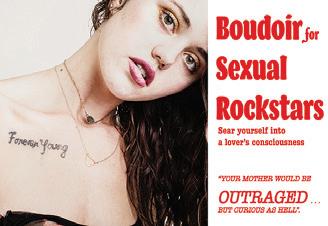
Be unforgettable. Sear yourself into a lover’s consciousness. Photo sessions $350 include three looks, a minimum of 25 retouched images, and book layout. Selfies will never capture the fullness and complexity of you. IG: @GMNEphoto GMNEphoto@gmail. com
A one-sided “open relationship,” fucking a er a crisis,
and more
By DAN SAVAGE
Q : It turns me on when my husband fucks other men. It pisses him off when I do. His proposed “fix” is he gets to fuck other men (because I like it) but I don’t get to fuck other men (because he hates it). This hardly seems fair.
a : If things being unfair turned you on—if the idea of being in a one-sided open relationship made your cock hard—you might be able to make this work. But unfairness doesn’t turn you on, so you can’t make this proposed “fix” work. Your options are a mutual agreement to close your relationship (no one gets to fuck other men) or agreeing to a one-sided Don’t Ask, Don’t Tell (DADT) relationship (he doesn’t hide fucking other men from you and you hide fucking other men from him). Your husband getting the fuck over himself is also an option.
Q : How do I get my libido back a er my house burned down in the LA fires?
a : “You don’t get your libido back, at least not yet,” said Claire Perelman, a certified sex therapist who lives and works in California. “You sit in the grief, you let it wash over you. When you’re ready, you turn towards pleasure and comfort, however you find it—naked cuddling, drawing yourself a bath, sensual touch. You can even invite grief into your bedroom: a threesome with you, your partner, and despair. Acknowledging the pain is the first step in moving through it.”
Q : Any tips or tricks for orgasms while on SSRI medications?
a : Throw absolutely everything you’ve got at it—genital stim, nipple stim, anal stim, brain stim (aka dirty talk), inert toys, vibrating toys—and enjoy the ride and/or getting ridden whether you have an orgasm or not. If you feel yourself getting close, push a little. If you don’t feel like you’re gonna get there, appreciate the pleasure you created and experienced instead of succumbing to frustration over the orgasm you didn’t have this time but might next time. (Also, talk to your doc about adjusting your medications.)
Q : What’s the craziest sex you’ve ever had?
a : Bent over in an East German guard tower on November 12, 1989, looking down through the orangetinted mirrored glass windows at the delirious crowd of Berliners tearing the Wall apart with their bare hands.
Q : What’s the best way to let a new partner know I’m inexperienced in the bedroom?
a : You can show ’em or you can tell ’em. And since there’s nothing more deflating than the look on someone’s face as they slowly realize you don’t know what you’re doing, telling is by far the better choice. Remember: low expectations are easily exceeded.
Follow Claire Perelman at her website, sexclarified.com, or at instagram.com/sexclarified. v
Read the full column, archives, listen to podcasts, and more at the URL savage.love. m mailbox@savage.love
SOCCER MOMMY + TOMBERLIN
BLIND PILOT + VIV & RILEY
UNCLE ACID & THE DEADBEATS
NELL' ORA BLU + JONATHAN HULTÉN
STARS
SET YOURSELF ON FIRE 20TH ANNIVERSARY TOUR + LYDIA PERSUAD
THE ROCK & ROLL PLAYHOUSE PLAYS TALKING HEADS + MORE FOR KIDS THE
THE MC TAYLOR GOLDSMITH SHOW + JONNY FRITZ
LIME CORDIALE ENOUGH OF THE SWEET TALK WILLIS
INTERVALS
MEMORY PALACE TOUR 2025 + VOLA / ARCH ECHO
LAST DINOSAURS + TIPLING ROCK / JASPER BONES
THE PSYCHOLOGY OF A MURDERER
MAGGIE WINTERS + CONNOR WOOD WE WENT TO THE GUINNESS FACTORY LAST YEAR
MARC BROUSSAR TIME IS A THIEF TOUR + KENDRA MORRIS
PARIS PALOMA CACAOPHONY TOUR
THE ALTONS & THEE SINSEERS CLUB HEARTACHE TOUR
ALABASTER DEPLUME IN THE ROUND + PATRICK SHIROISHI
EVAN HORNER + TIMMY SKELLY
ANDY FRASCO & THE U.N TRY NOT TO DIE TOUR + HAYLEY JANE BAND
SPAFFORD + HOT LIKE MARS